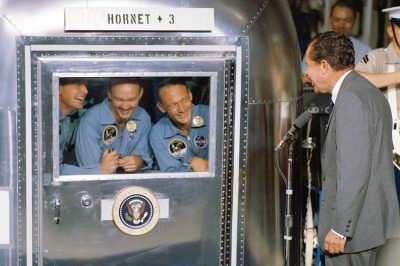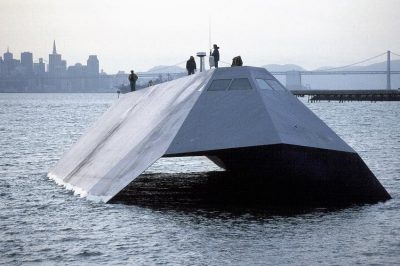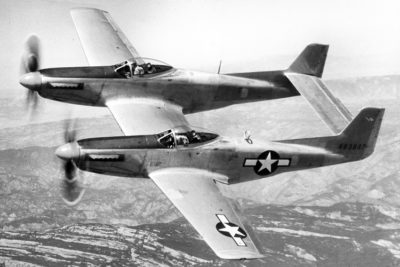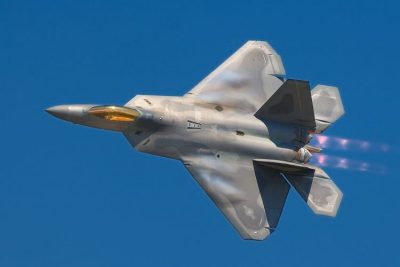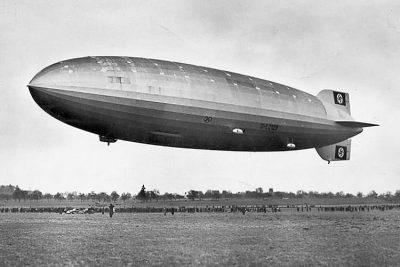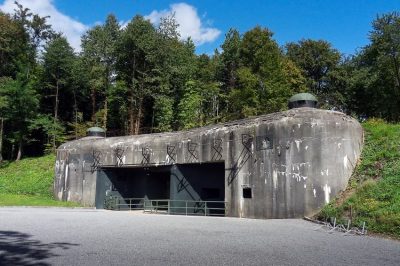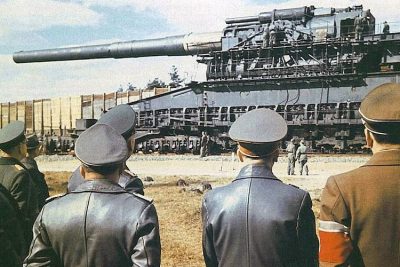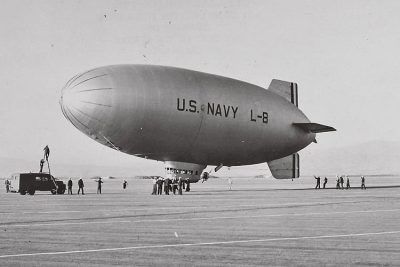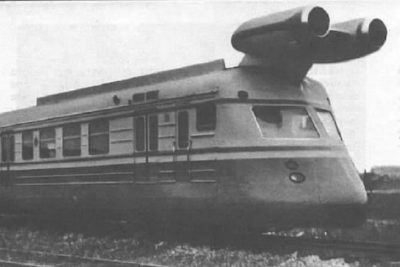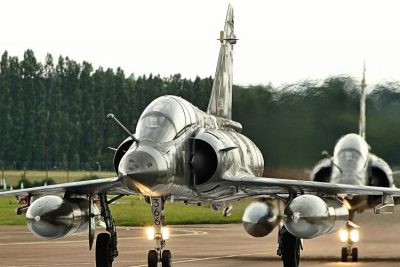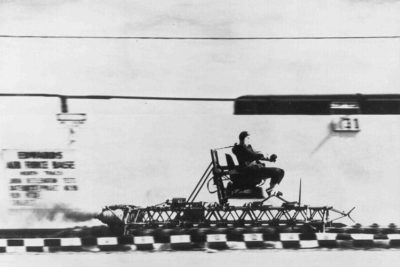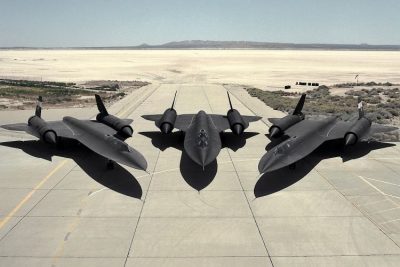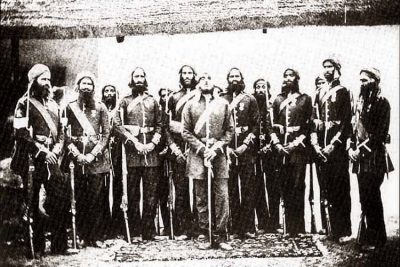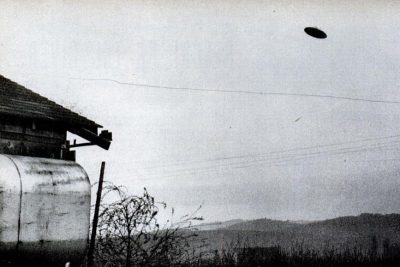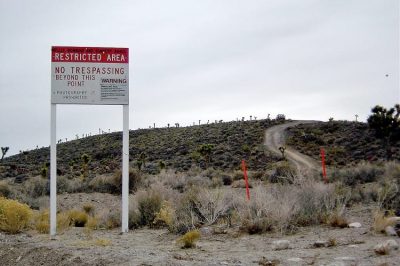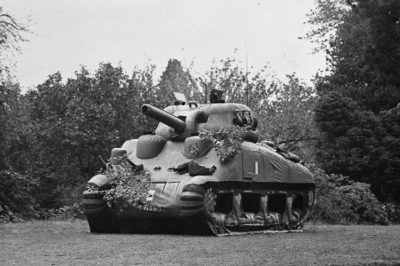The post Bartini Beriev VVA-14: The Cold War Scramble for Arms Gave Birth to an Amphibian Aircraft in Russia appeared first on .
]]>
Bartini Beriev VVA-14 in dilapidated condition. (Alex Beltyukov / Wikimedia Commons)
It takes little to almost nothing for us to take a trip back to the horrific time of the World Wars. Almost all inventions that are used more as a necessity today, either witnessed their inception or their development during the Wars, especially the Second World War. Following the disastrous Second World War, palpating tension between the United States of America and the Soviet Union gave birth to the Cold War. Under these circumstances, the 1970s saw the development of the Bartini Beriev VVA – 14, an in-ground aircraft, created by the Soviet Union.
As President Harry Truman had said in 1945, “We have to get tough with the Russians. They don’t know how to behave. They are like bulls in a China shop…We have got to teach them how to behave.”
The tension between the Soviet Union and the United States of America was a steady reverberating one. This arms race was bringing the world to the brink of mutual destruction for once and for all. The Bartini Beriev VVA-14 was quite an innovation. It had quite a few remarkable features and its capabilities, at the time, seemed endless.
The name says it all
Robert Bartini, the man behind this aircraft, was of Italian origin. The Fascist Revolution in Italy resulted in his immigration to the Soviet Union, to provide his expertise in the field of aviation.
A graduate of Milan Polytechnic Institute and trained in a Roman pilot school, Bartini practiced as an aviation engineer for several projects over the years. He gave birth to the idea of an anti-submarine aircraft in the 1960s. A collaboration with Beriev Design Bureau in the year 1972 finally produced the Bartini Beriev VVA – 14 prototype. The same year witnessed its first flight but it did not reach its full potential.

Bartini Beriev VVA-14. (Aleksander Markin. Александр Маркин / Flickr)
While working on the development of the aircraft, it was decided that the project would reach its completion in three carefully planned and executed phases. The initial phase, the VVA – 14M1, was orchestrated mainly to test and analyse the aerodynamic technology with rigid pontoons. These pontoons were soon replaced with inflatable ones that were attached to the ends of the central wings sections.
The following phase was consecutively named VVA – 14M2. It had been elevated a little higher by adding special advanced features to it. It was now capable of blasting through two engines into the cavity under its wings. These provided the aircraft with a much stronger lift than what was initially constructed. The aircraft now had vertical take-off capabilities, aided by batteries, which could generate enough power to lift the engines.
The final phase of development was quite naturally given the name VVA – 14M3. This was an aircraft that was functionally tested for vertical takeoff capabilities. It was now properly equipped with anti-submarine warfare, magnetic anomaly detection called BOR – 1 MAD and an array of modern equipment.
An aviation breakthrough
One of the most prominent features of the Bartini Beriev VVA – 14 was its ability to take off from water and fly at very high speed over large distances. While high altitude was a prime factor, it was also very important that the aircraft could skilfully fly at a low height, just above the sea surface and while using ground effect.
This project required extensive research. The first test run of the Bartini Beriev VVA-14 was incomplete, but it saw its completion in 1974. By then the inflatable pontoons were installed, thus permitting flotation and water test.

Bartini Beriev VVA-14 front view. (Mike1979 Russia / Wikimedia Commons)
A lot of research and failed tests later, the aircraft was proved to be a grand success, with a hundred and seven trips and a hundred three hours of flight time in its honour. The ultimate aim of the aircraft was to destroy the United States Navy Polaris missile submarines. Amazingly, a three persons’ crew was more than enough for a successful operation.
Amphibious: Cold-blooded beast of steel that functions over water as well
The most unique aspect of this aircraft is its structure. The Bartini Beriev VVA-14 is quite commonly referred to as the “amphibious” aircraft as well. The aircraft’s ability to function over water gives it a few features that might be called ‘amphibian-like’. Its ‘deadly’ nature also lent itself to a pun around the cold-blooded trait of amphibians.
The plane is built with an all-around metal frame that contains a few prominent and characteristic features. It contains a fuselage, central wing, sections with floats, torsion-box central wing, removable wing portions, tail, and a cruising engine’s nacelles over the fuselage.
The side sections of the plane essentially exist to fix the horizontal and vertical tail. The removable wing portions have slats, slotted flaps and ailerons, while the tail came with elevators and rudders. Aerodynamic controls governed the aeroplane above the evolution speed. However, jet vanes were used during vertical takeoff and landing.
History of the Bartini Beriev VVA-14 through the wars of the time
However, this enterprise could not graduate much further beyond the prototype and testing stage, resulting in two remarkable functioning models only. Robert Bartini, whose brainchild was this aircraft, suddenly passed away taking with him, the slow gradual progress of this project as well.
The primary aspect of the aircraft was its “wing – in – ground – effect” to travel with several very useful features. It is quite unfortunate that the aeroplane was never allowed to ripe to its fruition. Failed tests after Bartini’s death drained the Soviets of their motivation, thus, leading to the eventual cancellation of the project. The remaining prototype of the Bartini Beriev VVA-14 is currently installed in the Russian Airforce Museum in Monino, since 1987. Although, it is a significant part of history that remains on display, its dismantled state is quite a sad sight to behold. Nevertheless, history on display is always exciting.
Enjoyed this article? Also, check out “Hughes H-4 Hercules | The Largest Flying Boat That Flew for Only 26 Seconds“.
For more unusual stories & intriguing news follow STSTW Media on Instagram and Facebook. Also, join our live chat discussion on Twitter.
Do you have a story/photo for us?
We welcome your contribution at [email protected]. Please include your name, city, state, and country.
Fact Analysis:
STSTW Media strives to deliver accurate information through careful research. However, things can go wrong. If you find the above article inaccurate or biased, please let us know at [email protected].
RELATED
The post Bartini Beriev VVA-14: The Cold War Scramble for Arms Gave Birth to an Amphibian Aircraft in Russia appeared first on .
]]>The post USNS Comfort: A Ship of Hope Amidst Corona Crisis appeared first on .
]]>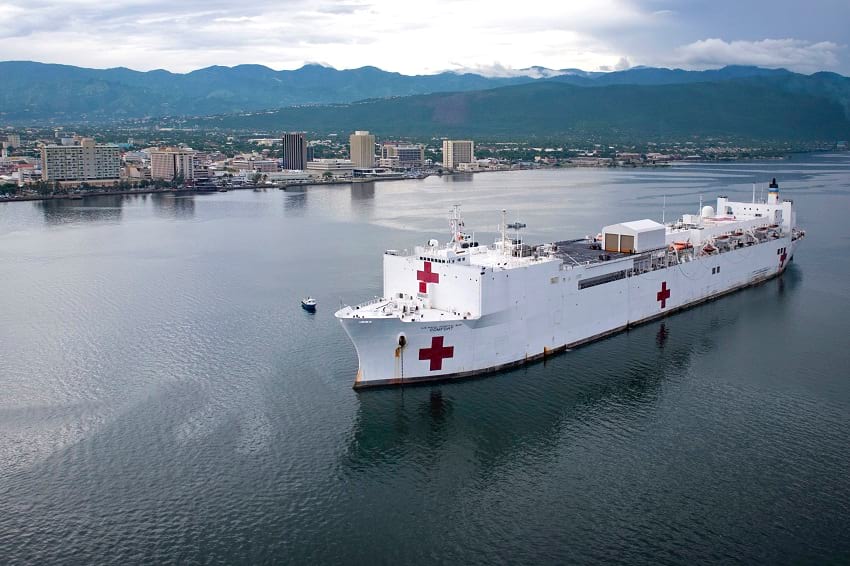
The hospital ship USNS Comfort (T-AH 20). (U.S. Navy photo)
The United States Navy boasts of some of the best and largest ships in the world. One such ship is the USNS Comfort (T-AH-20) which functions as a gigantic floating hospital and is currently stationed in New York City. The USNS Comfort is currently aiding New York City to combat the overcrowding in light of the global pandemic caused by the mutant coronavirus strain, COVID-19. The ship is nearly four decades old but can still house up to 2000 people, including crew and patients.
Interestingly, when the ship was initially constructed, it was to be used as an oil supertanker and was named the SS Rose City. The US Navy had given out a contract to the National Steel and Shipbuilding Company for this ship, along with its sister ship- the USNS Mercy. In 1987, the US Navy purchased both the ships from them to have them deployed.
Structure of the ship
Standing at 100 feet tall, the ship’s height is comparable to that of a ten-storeyed building. It has a deep draft and has the capacity to displace 70,743 tons of water. Over 894 feet long (272 meters), the USNS Comfort areas across a length of approximately 3 football fields. It is so large that, it must often be moored a mile away from the shore at the docking stations in ports.

USNS Comfort being escorted to New York Harbor, March 30, 2020. (U.S. Coast Guard)
A large day-and-night helipad has been provided within to accommodate large military-grade helicopters deployed to pick-up and drop patients during a crisis. The ship’s look, a stark white surface with a number of red crosses, helps to illustrate its purpose and protect the crew and cargo against violent naval attacks or piracy. Patients from the ships docked alongside the USNS Comfort are also allowed in.
Medical facilities within the ship
The USNS Comfort can be completely prepared and crewed in just about five days. The life force of the ship are the 12 operating rooms and 1,000 beds that support the different required levels of care. It houses 500 beds that are allotted for minimal case needs, 400 beds for intermediate cases, 20 designated for surgical recovery, and a further 80 for intensive care patients. The USNS Comfort has the capacity to receive and care for 200 patients every day.

Hospital beds aboard the USNS Comfort. (Ministerio de Defensa del Perú / Flickr)
The ship has a stellar full-scale medical facility that even includes a dental clinic, four x-ray machines, and a CT scanner. A pair of oxygen-producing plants, an optometry lab, and coolers to hold 5,000 units of blood, are integral assets of the ship. The various other onboard services include a satellite lab and a central area for sterile causality receiving. A medical supply department, along with a well-stocked pharmacy, is all included within the hull of this singular vessel. To support the smooth functioning of the medical facility, the ship has a huge laundry operation and its own morgue.

Surgery being carried out aboard the hospital ship USNS Comfort (T-AH 20). (U.S. Navy photo)
A logistical drawback
Despite its humongous size, the USNS Comfort faced major logistical disadvantages since it was not built to be a hospital. This made the process of moving around patients extremely tedious and a lot of additional safety measures had to be put in place to avoid any critical damage to the patients.
A major issue within the ship pertains to patient movement through the ship’s rooms and hallways. Since it was originally built as an oil tanker, the bulkheads used to remove the oil were left in place and the refits did not have hatches between them. The majority of the movement of patients from one part of the ship to another had to be made by moving the patients up to the main deck. They were then moved down again into other parts of the ship. This round-about route owing to the hallways not being effective for patient movement made the process rather cumbersome.
The many relief voyages of USNS Comfort
The USNS Comfort has been deployed for support at disasters and warzones alike, including ‘Operation Desert Storm’, ‘Operation Iraqi Freedom’ and the 2010 Haitian Earthquake. The ship has played an integral role in providing medical aids during all these operations.
1994: An exception to this would include the ship’s role during ‘Operation Uphold Democracy’ in 1994. In this case, when an internal unrest arose in Haiti, the USNS Comfort was sent in not as a hospital, but as a processing centre for the migrants. Civilian personnel were boarded instead of doctors to ID and process the Haitian migrants. Out of the 1,100 people who were processed, 400 were transported to Guantanamo Bay, Cuba, where the ship arrived in the month of June. Later that year, however, the USNS Comfort returned to Haiti as a hospital to receive casualties from the continued unrest and provide medical supplies. The ship finally went back to the homeport in October 1994.
2001: ‘Operation Noble Eagle’ was one of the most important deployments for the USNS Comfort. On September 12, 2001, the ship left for New York owing to the historic terrorist attack on 9/11. At pier 92 in Manhattan, the ship docked itself on September 14. During the stopover, 541 relief workers were treated for their many injuries, including near-fatal respiratory ailments. Navy personnel also provided mental counselling, and the workers were provided services by the local massage therapists. For this outstanding performance, the USNS Comfort received the Navy Unit Commendation medal.
2005: During ‘Joint Task Force Katrina’, the USNS Comfort had to leave Baltimore for the Gulf Coast with a mere two days of preparation to provide aid to those affected by Hurricane Katrina. Across the target sites in Mississippi and New Orleans, the ship treated 2,000 patients and remained in the area for medical aid for seven weeks thereafter. The ship was awarded the National Defence Medal for her impressive and tireless duty.
2007: The ship also ran an American humanitarian mission which commenced in June 2007 and provided access to healthcare for roughly 12 Central American, South American and Caribbean nations. Consequently, the USNS Comfort helped further the President’s agenda to increase Social Justice in the Western Hemisphere. This promoted the goodwill of the US and served the purpose of training their military in medical aid.
A beacon of hope amidst COVID-19 crisis
The USNS Comfort has been deployed on the East Coast with Navy Capt. Patrick Amersbach at the helm to provide hospital relief from the impact of COVID-19. USNS Mercy (T-AH-19), its sister ship, is the headship of this class of hospital ships in non-commissioned service with the United States Navy. Under the command of Navy Capt. John R. Rotruck, Mercy has been deployed to the West Coast of the US. March 27, 2020, marked the arrival of Mercy at Los Angeles Port while Comfort docked at New York City soon after on March 30. The aim of the two ships is to treat patients other than those with COVID-19 through medical and surgical care, freeing up land-based hospitals to deal with the deadly virus.
The two ships, though occupied scantily at the moment, is working to provide support during the pandemic. The staff on board is diligently helping move patients as fast as they can during this global crisis in order to provide medical assistance to those who are in need. In the weeks to come as the number of COVID-19 cases boom exponentially, the USNS Comfort and USNS Mercy could be vital assets that help turn the tide.
Enjoyed this article? Also, check out “MS The World: Life on Board the World’s Largest Residential Cruise Ship“.
Fact Analysis:
STSTW Media strives to deliver accurate information through careful research. However, things can go wrong. If you find the above article inaccurate or biased, please let us know at [email protected].
RELATED
The post USNS Comfort: A Ship of Hope Amidst Corona Crisis appeared first on .
]]>The post Why NASA Loves the Super Guppy Aircraft appeared first on .
]]>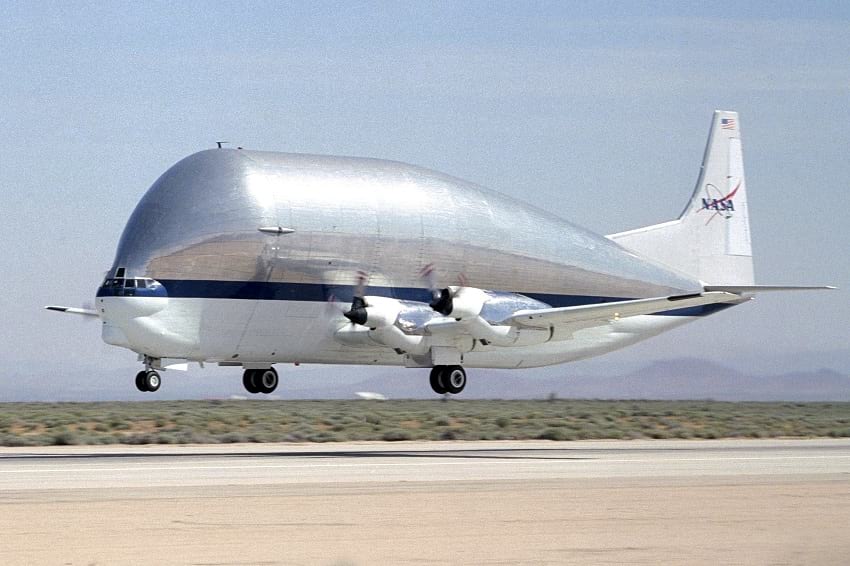
Aero Spacelines Super Guppy. (NASA)
The Aero Spacelines Super Guppy is a mammoth and commodious cargo transport aircraft that is used to haul oversized cargo components. Super Guppy is the ideal successor to its erstwhile avatar called Pregnant Guppy.
Aero Spacelines manufactured their first flight Pregnant Guppy in August 1965. The aircraft was named for its striking resemblance to a pregnant guppy fish. The company later released five such flights in two versions. Both the variants were colloquially called the “Super Guppy”.
Features of Super Guppy
The original Super Guppy, aka “SG”, was built straight out of the fuselage of a Boeing C-97 named Turbo Stratocruiser. It was the military edition of the “Stratocruiser” Boeing 377 passenger plane that operated in the 1950s.
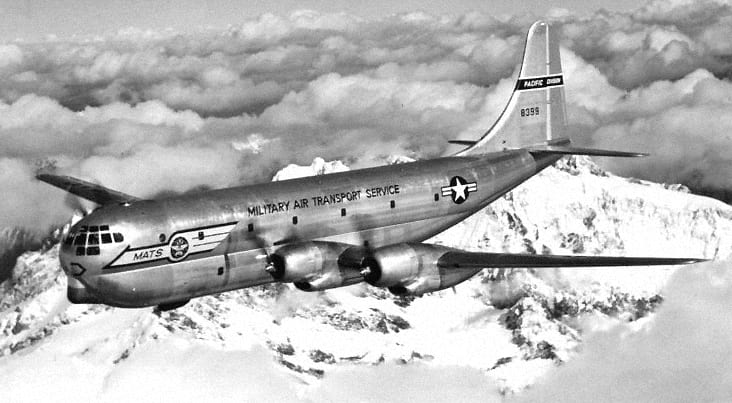
Boeing C-97 Stratofreighter. (US Air Force)
The main body of the original aircraft was extended to 141 feet in length. It was inflated to a diameter as big as 25 feet. The inner cargo compartment had a length of 94 feet 6 inches. The fuselage was tapered down to a width that measured 8 feet 9 inches. The nose could open sideways to provide entry to bulky cargos.

1969: Apollo 11 being loaded inside the aircraft. (NASA)
Apart from the modifications carried out in the fuselage, the aircraft was borne with Pratt & Whitney T-34-P-7 turboprop engines for more power efficiency and a longer travel range. It also had remodelled surfaces for its wings and tail. Super Guppy has a maximum payload capacity of 24,494 kilograms and can cruise at a maximum velocity of 300 miles per hour (480 kilometres/hour).
The key differentiator that sets Guppy apart, from other gigantic aircraft is its enormous and extra-wide cargo bay that allows transportation of military jet aircrafts having wingspans up to 7.6-meters. Therefore, although the Super Guppy is now obsolete, its unprecedented and perfect track record has proven its veritable merit.

Northrop T-38 Talon aircraft inside super guppy cargo compartment. (NASA)
Second guppy versions and its enhanced benefits
Super Guppy Turbine (SGT) was the official second variant of the original. It made use of Allison 501-D22C turboprop engines, unlike the first one that was powered with Pratt & Whitney T-34-P-7 turboprop engines. However, in contrast to the original, the 2nd version had the prime segment of its fuselage developed from scratch.
Only the cockpit, main landing gear, wings and tail of the original were retained. The swinged-out nose part, now rotated by 180 degrees, was dispossessed from a Boeing 707.
This slightly lowered the front portion of the aircraft, making the cargo-bay floor more levelled for an easier and streamlined loading mechanism.
It was possible to increase the width of the cargo bay floor to 13 feet. The aircraft was further lengthened to 111 feet 6 inches.
Because of these amendments in design, coupled with a uniquely created atmospheric-pressure-tolerant crew cabin, SGT facilitated a smooth non-interfering higher-altitude cruising. Also, the newly built aircraft could carry more freight up to 24700 kilograms, marginally more than what its predecessors did.
During the initial years of the 1970s, Airbus was using the twin Super Guppy Turbines to move aeroplane parts from local production depots to the central assembly plant in Toulouse.
From 1982 to 1983, two more Super Guppy Turbines were manufactured in France by UTA Industries after Airbus purchased the rights to build the aircraft.
Why was Guppy aircraft so indispensable to NASA?
The Super Guppy had a pivotal role to play in the transportation of crucial components for a lot of NASA’s important missions. President Kennedy was the one, who had announced NASA’s pioneering project to conquer the moon before 1970.
But during the initial phase, the only way, the Apollo rocket stages could be transferred from California to Florida was by shipping the constituent parts with the help of frustratingly slow boats. These used to ply across the Panama Channel. These harrowing journeys used up a lot of travel time which consequently delayed NASA’s plans.
It was NASA who then approached Aero Spacelines to help find them an aircraft solution capable of transporting a huge bulk weighing more than a few thousand kilograms in a single trip. The perfect response came in the year 1962 with the planning and the eventual deployment of Pregnant Guppy that once endured and carried some of the biggest payloads.

Pregnant guppy (1962) ready for its first test flight. (NASA / DFRC)
Since the first version Super Guppy has traversed more than three million kilometres for NASA. It efficiently and safely carried tremendously enormous yet incredibly fragile components and concentrated hardware for NASA’s prominent programs like Apollo, Gemini and Skylab. If not for Guppy, NASA’s endeavour towards sending astronauts to the moon by 1969 would not have fructified.
Still NASA’s favourite even after 53 years
Right up to the present time, NASA has consistently relied on Guppy to deliver gargantuan components meant for use by the International Space Station or other recent extra-terrestrial projects.
Though the original aircraft have now retired, NASA’s superbly improved and modernized Super Guppy (377SGT-F) still conducts flights all across the world. The grand flying machine is even used by different industries to convey massive consignments when not in use by NASA.
Currently, Super Guppy has been utilized for NASA’s ambitious Exploration Mission-1 (EM-1) to transfer the Orion crew module pressure vessel. The module is expected to be launched on board the Space Launch System which till date is the world’s biggest rocket ever built.
The pilot test flight is scheduled to be conducted sometime in 2018. In the course of the actual mission, Orion is believed to be travelling thousands of kilometres, far off the moon.
Current whereabouts of the five Guppies
Variants
1. Aero Spacelines B-377-SG Super Guppy
2. Aero Spacelines B-377-SGT Super Guppy Turbine
Flights
1. Super Guppy N940ns – Statically displayed at the Pima Air & Space Museum in Arizona, US.
2. Super Guppy Turbine F-BTGV – Statically displayed at the British Aviation Heritage Centre, United Kingdom.
3. Super Guppy Turbine F-BPPA – Statically displayed at the Musée Aeronautique Aeroscopia, France.
4. Super Guppy Turbine F-GDSG – Statically displayed at the Hamburg Finkenwerder Airport, Germany.
5. Super Guppy Turbine N941NA – Is currently in service with NASA at the El Paso International Airport in Texas, US.
Super Guppy’s contenders
Since Guppy’s debut in 1965, various other planes have been in the reckoning that could carry unbelievably huge loads. Amusingly, there has been a fierce battle amongst rival aircraft builders since the genesis of Guppy to construct an aircraft with the heaviest cargo payloads. Some of the other prominent planes of Guppy’s ilk are
1. The Antonov 225 Mriya
2. Lockheed C-5M Super Galaxy
3. NASA’s shuttle carrier aircraft
4. The Airbus Beluga
Enjoyed this article? Also, check out “Aerial Refuelling: The Inspiring Account of the KC-135 Stratotanker Military Aircraft“.
Fact Analysis:
STSTW Media strives to deliver accurate information through careful research. However, things can go wrong. If you find the above article inaccurate or biased, please let us know at [email protected].
RELATED
The post Why NASA Loves the Super Guppy Aircraft appeared first on .
]]>The post Bell Boeing V-22 Osprey: Two-in-One of Helicopter and Airplane appeared first on .
]]>
Bell Boeing V-22 Osprey. (Airwolfhound / Flickr)
Circa 1980. The American military was in for a serious setback. Operation Eagle claw, launched for release of American hostages in Iran, had to be called off. The inability of helicopters to reach the target in one go, and needing assistance on way, ruined the mission. A freak accident on a stopover killed 8 commandos. The failure raised some serious questions. And the answer was found in Bell Boeing V-22 Osprey, the aircraft which could land and take off like a helicopter, and travel long distances at high speed like an aeroplane.
Tiltrotor is the switch between 2 modes
Quick and precise hit over a long-range is key to the success of military operations. Hence, right since the Second World War, a need was felt for a fusion of helicopter’s vertical lift, and aeroplanes’ horizontal speed. The combo was finally developed by Bell Helicopter, Textron, in the 1950s. Named Bell XV-3, it was an aeroplane with wings having rotating fans/ propellers at the tips. The propellers could tilt 90 digress (tilt-rotor concept) for 2 functional positions. One, vertically upright, like propellers in a helicopter. Two, horizontally, towards the nose of aircraft, like in aeroplanes. Fans were rotated by turboshaft engines located in the belly of aircraft.
In helicopter mode, propellers rotate in the opposite way
In position one, aircraft could lift vertically from the ground to become airborne and land on ground similarly, like a helicopter. In two, the aircraft could moves linearly like an aeroplane. The linear speed in the air was 185 miles an hour, much faster than helicopters of that era. The fans located on wingtips rotated in different directions. That provided stability without the need of a tail fan used in conventional helicopters. Successful in more than 110 transitions from a helicopter to airplane mode, Bell XV-3 was discontinued following one accident. Nevertheless, the success of tilt-rotor for 2-in-1 aircraft was established beyond doubt.
Bell XV-15: Engine and propellers were conjoined in 1977
Bell XV-15 program was picked up in 1977. This time the turboshaft engine and the propeller fan, instead of being located at different places, were merged into one functional unit. The unit was installed on the tip of the fan, and the unit as a whole acted as tilt-rotor. The rotating blades could face forward (like an airplane) or upwards (like a helicopter). It was an improvement over the earlier version in 2 ways. One, tilt-rotating was simplified. Two, more space could be made available for passengers and equipment

Bell XV-15, VTOL. (NASA)
America got serious for Vertical Lift Aircraft
The debacle of Iran Hostage crisis force pentagon to go for long-range transport aircraft which could have taken their commandos up to Tehran in one sortie, without midway halts and refuelling. So, in 1981, Bell Helicopter, Textron, was commissioned to develop Joint Services Advanced Vertical Lift Aircraft (JVX).
In spite of hiccups, programme V-22 remained in force
The contract for JVX was won by Bell-Boeing in 1983 and several varieties of aircraft were produced. These included variants for Marine Corps, Air Force, Navy and Army. On May 23rd, 1988, Bell’s Flight Research Centre produced the first Osprey under the V-22 program. The program though ran into rough weather. The cold war between America and Russia was heading to an end. Consequently, there was a drastic reduction in the defence budget and V-22 faced the brunt of cost-cutting. There were attempts even to close down the programme. But the program survived, in spite of accidents which caused a great loss of men and material.
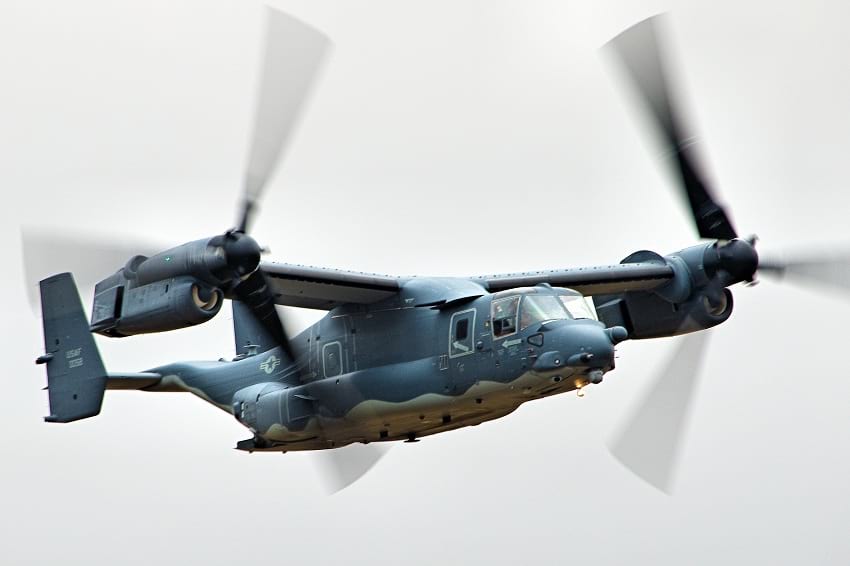
CV-22 Osprey with rotors facing forward. (Airwolfhound / Wikimedia Commons)
Bell Boeing V-22 Osprey come in several variants
The present-day Osprey is the perfect answer to the failure of Operation Eagle Claw in 1980. Equipped with 2 Rolls Royce Engines, it can carry 24 passengers in addition to 4 crew members internally, and ferry 12,500 pounds in an external slung load (artillery, land vehicles, and supplies) externally. MV-22 variant of it can fly at a speed of 276 miles an hour and cover a range of 230 miles. It can also be refuelled in the air to increase the range. In May 2015, it covered a distance of 2,500 miles, from a Pacific island to Nepal.

MV-22 Osprey after landing on the Japan Maritime Self-Defense Force helicopter destroyer. (U.S. Navy)
More variants are being manufactured
Presently, the number of Ospreys with the US Marine Corps is 360. Air force has 50 and Navy 48. The difference between MV-22 and CV-22 is that the latter’s fuel carrying capacity is 304 gallons more as compared to former. Hence CV-22 can cover a greater distance, albeit at a slower speed. For cargo shipment, the US Navy has ordered for 38 CMV-22Bs, which can travel a greater distance than other variants.
MV-22 and CV-22 have seen action in Iraq, Syria, Africa and Afghanistan. Ospreys, because of tilt-rotor, can’t carry side-mounted weapons like traditional helicopters. Only light machine guns are carried, at the back. Efforts are underway to develop a belly-mounted gun compatible with JVX.
Commercial tilt-rotors will arrive soon
Notwithstanding trials and tribulations, the idea of tilt-rotor, and its manifestation as V-22 Osprey is here to stay. Bell V-280 Valor, another variant of the genre, is slated to replace UH-60 Blackhawk in Army.
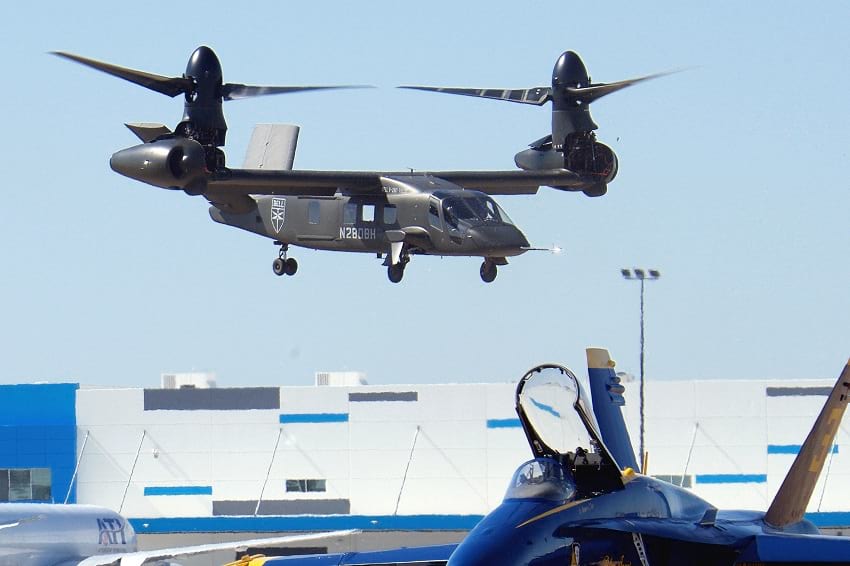
Bell V-280 Valor. (Danazar / Wikimedia Commons)
A commercial tilt-rotor, AgustaWestland AW60, is being developed by Leonardo – the aviation giant of Europe.
American Navy shall have an upgraded version, CMV-22Bs very soon, in 2020. Marines and Air force shall work with their present stock for long.
V-22 program, starting from 1980, has come a long way. Ospreys would remain signature combat aircraft of the US military, till at least, the middle of the present century.
Enjoyed this article? Also, check out “F-82 Twin Mustang Aircraft – The Dual Cockpit Fighter of the Forties“
Fact Analysis:
STSTW Media strives to deliver accurate information through careful research. However, things can go wrong. If you find the above article inaccurate or biased, please let us know at [email protected].
RELATED
The post Bell Boeing V-22 Osprey: Two-in-One of Helicopter and Airplane appeared first on .
]]>The post Sea Shadow (IX-529): The Story of Surreal Stealth Ships Which Defy the Enemy’s Stranglehold and Strike appeared first on .
]]>
Sea Shadow (IX-529) sailing through Californian waters, 1999. (US Navy)
The element of surprise is crucial to victory in warfare. This can be achieved by escaping the enemy’s vigil. Then only, it is easy to hit the enemy at a chosen time and place. This happened at Pearl Harbour, the U.S Naval base near Hawaii. Japan took America by surprise, destroying 20 ships, 300 planes, killing 2400 and wounding 1000 people. In vengeance, America nuked Japan, and the world changed forever. Warfare too changed radically. Stealth vehicles became the lifeline of the war game. These vehicles could escape the enemy’s IFF (Identification of friend or foe) screening and slip into the enemy’s territory unnoticed. The trend began with radar-defying aircraft. Subsequently, the technology was applied to naval ship- Sea Shadow (IX-529).
The challenge is to neutralize waves which locate movement
The three keynotes of IFF (identification of Friend or Foe) exercise are the sonar (sound navigation and ranging), the radar (radio signals) and the infrared (heat sensors) waves. The stealth ships must escape these three to survive and succeed. Stealth technology is all about facilitating such ‘escape’ and is in great demand worldwide. Reflecting surface of the ship is called the Radar Cross Section (RCS). An effort is made to reduce RCS through shape, design and the painting of Radar Absorbing Materials (RAMs) on the ship body.

Photo of Sea Shadow (IX-529) from above. (U.S. Navy)
The first stealth carrier was an aircraft
The American Aerospace company- the Lockheed, made radar defying fighter plane, F-117 Nighthawk which saw action in the Gulf War of 1991. The outside of the plane was dotted with angular surfaces. Any radiations which fell on these surfaces got scattered in multiple directions. At the same time, radiations also got absorbed into a coat of radar absorbing material (RAM) applied on the plane’s outer surface.
The little amount of radiations or radio waves which got reflected into the enemy radar, don’t suffice for proper identification of the aircraft. So, the aircraft escapes the enemy’s preventive assault on it. If an aircraft could `escape’ thus, why not a naval ship? On this premise was built the Sea Shadow (IX-529) an experimental stealth ship. Though it remained experimental only and wasn’t put into action, it opened the way for an improved version of its class.
From aircraft, the idea was planted on naval ships

F-117 Nighthawk during flight. (Staff Sgt. Aaron Allmon II)
Sea Shadow (IX-529) was built and tested on a submersible ship called Hughes Mining Barge (HMB-1). It was a joint venture of DARPA (Defence Advanced Research Projects Agency), the US Navy and Lockheed. Technically, Sea Shadow was a SWATH ship, i.e. ‘Small Water Plane Area Twin Hull’ ship. Two hulls, instead of a conventional one, were provided for balance and buoyancy. The twin-hull stayed below the water surface. SWATH ships travel at a faster speed, has a higher carrying capacity, but consumes 80% more energy than the single hull types.
Sea Shadow (IX-529) remained a learning exercise
Each of the two hulls of IX-529 had a propeller, a stabilizer and hydrofoils (an arrangement that lifts the hull up to reduce friction when a boat moves at a fast speed). The ship was thus designed to ensure that it remained stable even when the sea was rough with waves reaching up to 18 feet high. Ship’s first trial in 1981 was a failure as it couldn’t dodge the surveillance systems. A course correction was made by repositioning motor propellers and further trials were held in 1985 and 1986. The exercise proved useful for the future endeavours, but Sea Shadow itself could barely reach a functional status. In 1993 it was put up for public viewing. Finally, in 2012, it was sold and dismantled.

Sea Shadow (IX-529), at Hughes Mining Barge before being scrapped. (Stephen Schafer / Wikimedia Commons)
The thread of IX-529 was picked up by USS Arleigh burke ships
In the meanwhile, the first ship of Arleigh Burke-class destroyer was commissioned in America on 4th July 1991. It was another genre of stealth ship equipped with the computer-radar-and-weapon system. It was named after Admiral Arleigh Burke, the Hero of World War II, who later became chief of Naval Operation. The ship was designed for anti-aircraft, as well as anti-submarine action. The hull and the mast of the ship were designed to dodge the enemy radar. It had an all steel construction, an improvement over aluminium-admixture used in earlier versions, as aluminium was vulnerable to fire. Double spaced steel was put in ship’s vital spaces for protection from rocket attacks. Multiple-angle surfaces in place of the vertical surface, and tripod mast in place of the traditional lattice mast; these were the unique features of Arleigh Burke design which made the ship undetectable by anti-ship missiles.
Zumwalt-class destroyer succeeded the Arleigh Burke-class destroyer
Modernization and updating of Arleigh Burke led to a new series of stealth ship, USS Zumwalt (DDG-1000). A game-changer in warfare, Zumwalt had a smooth outer surface with sharp angles. It was so designed that it could easily tear through massive water waves. The hull was wider below the waterline than above it. This effectively diminished the ship’s 190-meter Radar Cross Section (RCS) to that of a small boat. Motors were electrically driven and the exhaust pipe was kept cool. This reduced the chances of infrared and sound waves locating the ship’s position with accuracy. However, by 2008, there were issues related to manufacturing cost and technological integration demanded by the American navy. Hence Zumwalt was laid down, to be taken over by improved editions.

USS Zumwalt (DDG-1000). (SurfaceWarriors / Flickr)
And the story goes on, and on
First developed by the German Navy, the stealth ships have come a long way and are being used by all countries of the world. ‘Visby-Class’ of stealth ships of the Swedish Navy are best of the lot internationally. Other famous names of the genre are British Type 45, India’s Shivalik range, Braunschweig Corvettes of Germany, and Houbei Missile boat of China. Doubtless, best in warfare is a transitory phase, and technological upgradation must go on ceaselessly all the time.
Enjoyed this article? You would also love “Lockheed Blackbird SR-71: The Fastest, High-Altitude Reconnaissance Aircraft in the World“.
Fact Analysis:
STSTW Media strives to deliver accurate information through careful research. However, things can go wrong. If you find the above article inaccurate or biased, please let us know at [email protected].
RELATED
The post Sea Shadow (IX-529): The Story of Surreal Stealth Ships Which Defy the Enemy’s Stranglehold and Strike appeared first on .
]]>The post Convair NB-36H: The only American Aircraft to Carry an Operational Nuclear Reactor appeared first on .
]]>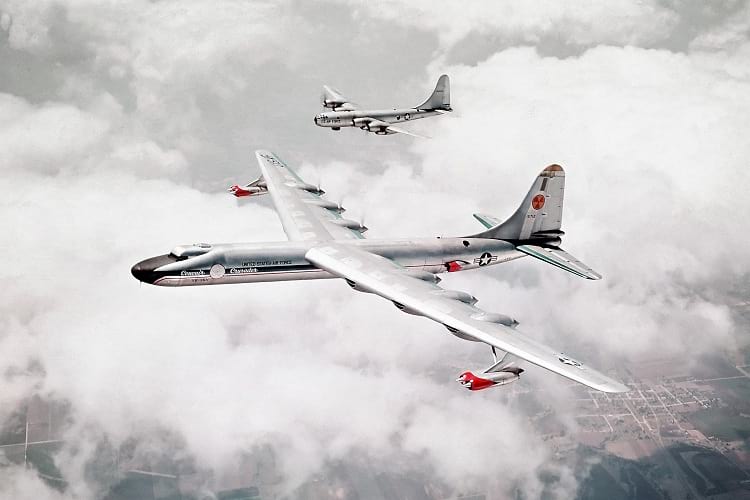
Convair NB-36H Peacemaker accompanied by Boeing B-50 Superfortress. (USAF)
Nicknamed the ‘Crusader’, the Convair NB-36H was created to prove the efficacy of carrying a nuclear reactor by air. The ultimate goal of the program was to create nuclear-powered aircraft with limitless power, dubbed Convair X-6. The Convair NB-36H was initiated into the US Army Air Force under the Aircraft Nuclear Propulsion (ANP) Program.
The NB-36H under the hood
The NB-36H was built using elements from a fleet of the Convair B-36 bomber, which had been destroyed in a tornado, in 1952, in Texas at the Carswell Air Force Base. Interestingly, the NB-36H is an earlier prototype compared to the B-36. However, it was much more cost-effective to use the salvageable parts to overhaul an early prototype as opposed to repairing the damaged fleet.

Convair B-36 bomber. (U.S. Air Force photo)
The NB-36H had a newly designed front compartment. This compartment was heavily coated with lead, and integrated yellow-tinted lead glass on the windows to shield the members of the crew from radiation. Though it was the ultimate goal of the program, the Convair NB-36H was not powered by a nuclear reactor. The reactor could, in fact, be extricated from within the aircraft using a crane, when on the ground. Weighing 35,000 pounds, the air-cooled atomic reactor was of a 1000-kW (or 1 megawatt) design. The bomb bay in the middle of the flight housed the reactor, hung on a hook, for quick loading and unloading. Time is of the essence for nuclear reactors, as they must be stored underground, to prevent accidents, as much as possible. ‘Project Halitosis’, a system for monitoring radioactive gases from nuclear reactors, was in use to ensure safety.
The crew compartment of the Convair NB-36H was located up front in the fuselage nose section. The crew and avionics cabin was lined with lead and rubber, and weighed an incredible 11-ton. The NB-36H, however, could only carry up to five crew members, including the pilot, co-pilot, two nuclear engineers, and a flight engineer. The atomic reactor was placed in the far end of the plane. The length of the aircraft was 49.38m (162 ft 1 in), with a height of 14.23 m (46 ft 8 in). The wingspan of the NB-36H was 70.10 m (230 ft), with a wing area was of 4,770 square feet (443.3 square meters). The loaded weight of the aircraft was 162, 305 kg (357, 500 lb), and the maximum speed which it could achieve in-flight was 676 km/h (420 mph).
The first flight of NB-36H and safety protocols
On 17th September 1955, the Convair NB-36H took off for the first time. The test pilot flying the NB-36H was A. S. Witchell, Jr. The test flights took place in sparsely populated areas and the reactor was only switched on when they were at a very high altitude. On every test flight, a platoon of marines flew in C-97 next to the NB-36. In case of a crash, the platoon of armed marines would parachute down and cover the test aircraft. The Convair NB-36H was a classified project up until late 1955. There was a risk of radioactive contamination in case of a disaster or an accident. A hotline directly to the President’s office was set up in case of an ill-fated crash.
Why was the Convair NB-36H shelved?
Between September 17, 1955, and March 1957, the Convair NB-36H performed 47 test flights. The project covered a whopping total of 215 hours of flight time over Texas and New Mexico. Focus on the development of the NB-36H, however, soon started reducing. The tinted glasses and shielded compartments did protect the crew from dangerous radiations from the nuclear reactor. However, nothing could eliminate the dangers of contamination in case an accident was to occur. This was a major drawback of the project that was brought to light during the test flights. The functional nuclear reactor was removed from within the aircraft, to prevent disaster. The Aircraft Nuclear Propulsion (ANP) program was completely scrapped out in 1961, thus sealing the fate of the Convair NB-36H.
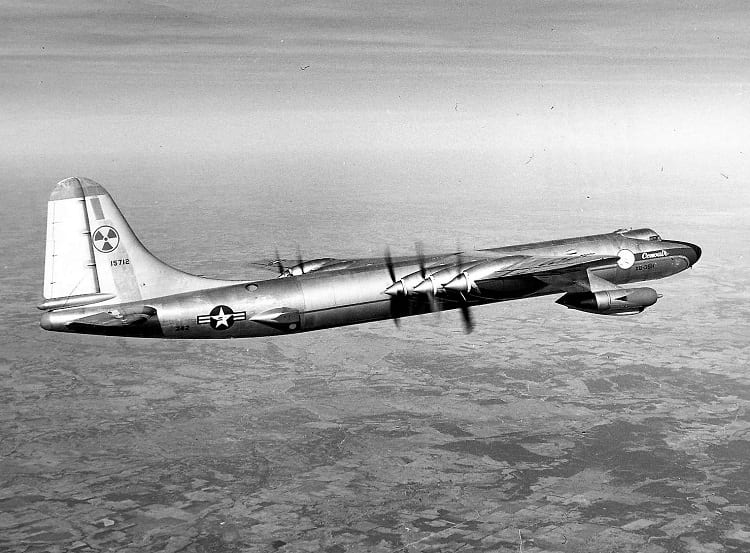
The Convair NB-36H had radiation warning symbol on the tail. (Robert Sullivan / Flickr)
With tensions of the Cold War brewing, the US government wanted to switch gears and fund the development of heavy bomber aircraft with jet engines. The progress of the ANP program was exceedingly slow. Even so, President Dwight Eisenhower continued to fund the project despite not being convinced of the need for this program. By the end of the 1950s, most people saw nuclear-powered planes as a redundant concept owing to the seminal advancements in ballistic missile and supersonic aviation development. The Aircraft Nuclear Propulsion program was finally cancelled by John F. Kennedy in 1961, owing to the ‘remote and dangerous’ nature of the project.
Was the project relevant at all?
Despite the project being shelved quite early on, the Convair NB-36H remains a hallmark project due to the scientific work that had gone on to sustain the project. Procedures of handling liquid metals or fused salts involved in the project were indispensable for NASA when they developed their nuclear reactors and generators. Till date, the Convair NB-36H is the only American aircraft to have carried an operational nuclear reactor.
Enjoyed this article? Also, check out “Lockheed Martin F-22 Raptor: A Fifth-Generation Monster in the Sky“.
Fact Analysis:
STSTW Media strives to deliver accurate information through careful research. However, things can go wrong. If you find the above article inaccurate or biased, please let us know at [email protected].
RELATED
The post Convair NB-36H: The only American Aircraft to Carry an Operational Nuclear Reactor appeared first on .
]]>The post Lockheed Blackbird SR-71: The Fastest, High-Altitude Reconnaissance Aircraft in the World appeared first on .
]]>
Lockheed Blackbird SR-71. (Matt Morgan / Flickr)
Built by Lockheed, to carry out long-range, strategic reconnaissance missions— the SR in SR-71 stands for strategic reconnaissance— the Lockheed Blackbird SR-71 was in operational use from 1964 to 1998. At this point, since the enormous expense of building and maintaining these planes became untenable for the United States government, the Lockheed Blackbird SR-71 was retired from service.
Building a superior spy plane
In late 1957, the CIA and defense contractor Lockheed first discussed the possibility of building an aircraft that was virtually undetectable by radars. The United States could then use this aircraft to spy on its enemies with complete impunity. They decided to call the project Archangel and Lockheed’s Skunk Works Division in Burbank, California, began work on it in 1958.

Clarence “Kelly” Johnson, the designer of SR-71. (SDASM Archives / Flickr)
The head of the Skunk Works Division was an aerospace engineer named Clarence “Kelly” Johnson, and he was the one that came up with the innovative design for the new plane, the A-12. He and the other aerospace engineers took over 10 months and a total of 11 design reiterations to come up with a final design version. The first plane they built was the A-10, but it turned out that its design didn’t render it undetectable on the radar. So, they went back to the drawing board in March 1959 to modify and refine the design and came up with a new A-12 version that had a 90% reduced radar cross-section.
The CIA approved of the new design and gave Lockheed the go-ahead to build the planes. Granted a budget of US$96 million on 11 February 1960, Lockheed began work on building the new A-12 reconnaissance planes. That same year, in 1960, the American pilot, Gary Powers, was famously shot down and captured by the Russians for flying a U-2 spy plane over Russian territory. The lesson the CIA took from this incident was to build faster, more undetectable planes like the A-12 and subsequent SR-71.

Lockheed A-12. (U.S.Air Force)
Lockheed eventually built 13 A-12 planes and the two A-12 variants, the YF-12 interceptors and the M-21 drone carriers. They flew the first A-12 on 25 April 1962 at Nevada’s Groom Lake. It was manned by only one pilot and was equipped with a camera and reconnaissance instruments.
Powered initially by the Pratt & Whitney J75 engine and later the Pratt & Whitney J58 engine, the A-12 surpassed the speed and altitude of the U-2, a reconnaissance plane that Lockheed had previously built for the CIA. Also, the Lockheed A-12 reconnaissance aircraft was the first plane in the world to be built with a reduced radar cross-section. American pilots flew these planes over Vietnam and North Korea. The SR-71 was developed from this design. And it was the development of the far better SR-71, as well as budget concerns, that led to the United States government cancel the manufacturing of more A-12 planes on 28 December 1966.
The Lockheed Blackbird SR-71
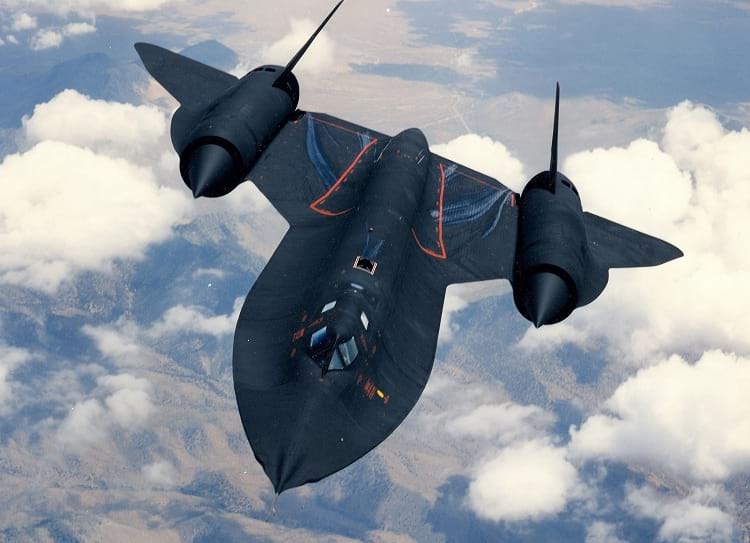
SR-71 during flight. (Matt Morgan / Flickr)
Under Clarence “Kelly” Johnson’s direction, Lockheed’s Skunk Works Division built and flew the first SR-71 on 22 December 1964. Design-wise, the plane was a vast improvement on the A-12. To render it undetectable on the radar, the designers equipped it with a light aircraft’s radar cross-section and an anti-radar iron ferrite coating. Furthermore, they built the plane with an aluminium internal airframe, titanium skin, and asbestos and epoxy vertical rudders and edges. This made the SR-71 virtually undetectable on the radars of the day. Or, if the radars did spot it, they took it to be a small and insignificant object. It also helped that the Lockheed SR-71’s entirely black body—which prompted the Blackbird nickname—melded well with dark skies. Furthermore, the plane’s materials allowed it to fly at very high altitudes and, at the same time, withstand the high temperatures that its incredible speed generated. The pilots had to wear specially designed flight suits—the David Clark Company’s Model 1030 pressure suits— to survive the intense pressure at altitudes of 85,000-90,000 feet.

The crew of Lockheed SR-71 in their pressure suits. (Jim Ross / NASA)
Lockheed built 32 SR-71 planes in total. Out of these, the United States Air force lost 12 to accidents. None of the SR-71 planes were ever downed by enemy fire. The SR-71’s capability of flying at high speeds and at high altitudes made it possible for it to fly faster than any surface to air missiles that were fired at it. One plane was almost hit by a missile on 26 August 1981 over the demilitarized zone between North and South Korea but managed to evade and out-fly it.
The SR-71’s speed made it the fastest plane in the world, breaking the record that had previously been held by the Lockheed YF-12.
Retiring the Lockheed Blackbird SR-71
To date, no other aircraft has surpassed the SR-71 in speed. Most people find it surprising that, given the many technological advantages of the Lockheed Blackbird SR-71, that the United States government eventually retired the plane from active service. The government, of course, had valid reasons for doing so.
First of all, with the development of advanced and less expensive satellite technologies as well as swifter missiles by the Russians, the SR-71’s speed was no longer going to render it as invulnerable as it once was thought. Also, it was very expensive to fuel, operate, and carry out the regular maintenance of the SR-71. According to some estimates, if you counted all the costs involved, it cost the United States government about $200,000 to fly the plane for an hour.

An SR-71 that was being used by NASA. (Matt Morgan / Flickr)
Since the expense of maintaining a fleet of SR-71 was untenable, the United States government retired the aircraft in 1990. It was briefly brought back into service between 1995 and 1998 by Congressional order, and NASA used it for research missions in 1999. However, the era of the Lockheed Blackbird S-71 was past and it was soon permanently retired.
Enjoyed this article? Also, check out “Convair NB-36H: The only American Aircraft to Carry an Operational Nuclear Reactor“.
Fact Analysis:
STSTW Media strives to deliver accurate information through careful research. However, things can go wrong. If you find the above article inaccurate or biased, please let us know at [email protected].
RELATED
The post Lockheed Blackbird SR-71: The Fastest, High-Altitude Reconnaissance Aircraft in the World appeared first on .
]]>The post Bagger 288: One of the Heaviest Land Excavators on Earth appeared first on .
]]>
Bagger 288 (left) next to a CAT wheel loaders (right) at Garzweiler surface mine. (© Raimond Spekking / CC BY-SA 4.0)
If there any vehicle on earth that is heavier than the Eiffel Tower and taller than the Statue of Liberty, then it must be Bagger 288. It is a German-made bucket-wheel excavating mining machine that can claw out an entire city in a matter of hours.
The excavator uses its revolving wheel of 18 buckets as a shovel to shift 8.5 million cubic feet of dirt every day. When it reaches a seam of lignite or brown coal, Bagger 288 can harvest at least 2,65,000 tonnes of fuel every day from open-pit mines.
Surprisingly, though, this behemoth excavator needs just four to five people to operate it.
Bagger 288 has four conveyor belts that receive the overburden of soil and rock from the buckets. Each belt is at least 10.5 feet wide. It is big enough to transport a car with much ease. The conveyor belts then carry the excavated material to their destination.
Bagger 288 weighs 13,000 tons
While excavating the soil or rock, Bagger 288, which weighs 13,000 tons, crawls at a stately 0.4 mph thanks to its 8,600 square feet of the tread. Due to its sheer weight, when Bagger 288 travels on the highway, the road must be fully rebuilt, because, the vehicle’s weight crushes the cement and any other material on its path. After careful planning and preparation, Bagger 288 has also crossed rivers.

The tread of Bagger 288. (Max Pixel)
The excavator gets its electricity feed with the help of 5,600 feet of electrical cables. Each cable’s diameter has the size of a strong man’s arm. At any given time, the cables can use as much juice as required by at least 20,000 people.
Bagger 288 is covered under 88,000 pounds of paint. It includes the two pylons, each at least 148 feet tall and is supported by steel suspension cables that extend to 7,218 feet.
According to Mining Monster magazine, the 71-feet-tall bucket-wheel has the height of a 7-story building. And each of the monstrous structure’s 18 buckets weighs 3492 kg approximately when empty. Also, each bucket can scoop up at least 230 cubic feet of soil. This is sufficient to fill a cargo van.
It is in operation in Germany
Bagger 288, one of the heaviest land excavators in the world today, is in operation at the open pit lignite mine at Garzweiler in North Rhine-Westphalia, Germany.
The $100 million excavator was built by the German company called Krupp. Today the company is known as ThyssenKrupp. Bagger 288 was built for the energy and mining company Rheinbraun. Built in 1978, it is also known as a mobile strip mining machine.

A bucket-wheel excavator at work. (Arcticbear1 / Wikimedia Commons)
Machines like Bagger 288 are used to mine large volumes of minerals and for long periods of time as they are economical and efficient. The bucket wheel excavator can move lignite equivalent to that of 40,000 workers, i.e. 240,000 cubic meters. This is equal to loads of over 10,000 dump trucks.
The excavated lignite is then transported on conveyors and the overburden is then dumped by spreaders.
Takes 3 weeks to travel 22 km
The gigantic bucket wheel excavator is driven by four 840 kW motors and the combined drive power of the buckets is 3,360 kW. It is equivalent to 30 compact cars or more. When the excavator crawls over grass, gravel or soil it leaves tracks that are not deeper than a footprint of a human being. At a speed of 10 metres per minute, Bagger 288 takes at least three weeks to travel a distance of just 22 km.
Earlier, these bucket wheel excavators were mining softer materials like lignite, but today excavate hard rock and they offer an efficient alternative to surface mining machines.
Bagger 288 supersedes NASA’s crawler-transporter
It is interesting to note that Bagger 288 supersedes NASA’s Crawler-Transporter that is used to transport the Space Shuttle and Apollo Saturn V launch vehicle.

Crawler-transporter transporting space shuttle to the launch pad. (NASA)
Owned and operated at present by RWE AG, a large utility company, Bagger 288 is part of a group of same-sized vehicles like Bagger 281, which was built in 1958. In 1975 Bagger 285 was built, in 1976 Bagger 287 was built and in 1995 Bagger 293 was built.
When it comes to moving mountains, RWE Bagger 288 earth digger has no peers. In Rosia Montana, Romania mountains can be moved with similar machines to excavate gold. Rosia Montana Gold, which is a Canadian company, intends to accomplish this with the help of Bagger 288.
In popular culture, Bagger 288 was used in a 2012 movie named ‘Ghost Rider: Spirit of Vengeance’. In the film, the protagonist is made to use the Bagger 288 to threaten his enemies.
Enjoyed this article? Also, check out “CSCL Globe: The Largest Container Vessel in the World, Until MSC Oscar Usurped its Ranking“.
Fact Analysis:
STSTW Media strives to deliver accurate information through careful research. However, things can go wrong. If you find the above article inaccurate or biased, please let us know at [email protected].
RELATED
The post Bagger 288: One of the Heaviest Land Excavators on Earth appeared first on .
]]>The post MS The World: Life on Board the World’s Largest Residential Cruise Ship appeared first on .
]]>
MS The World. (Bob Adams / Flickr)
The World is a privately-owned, 644-foot, luxurious, residential ship. It is a floating home with a private veranda from where residents can view constantly changing scenery.
About MS The World
Knut Utstein Kloster first came up with the idea of a residential ship. He is a Norwegian shipping magnate whose family successfully runs various cruise ships. The Swedish company Öresundsvarvet built the ship’s hull in Landskrona, and Mekaniske Verksted of Rissa, Norway, made the other parts. The ship officially launched in March 2002 in Oslo.
Residensea, a business based in Miramar, Florida, USA, operates MS The World, and they have registered the ship in the Bahamas. The ship’s home port is Port Everglades in Fort Lauderdale, Florida.
Alongside Residensea, the ship’s residents are involved in its management. They have an elected board of directors and a number of committees. These decide what types of activities will be available to the residents, the sea and ocean routes the ship is going to follow, in which countries and ports the ship is going to dock and for how long, and how to manage the ship’s finances.
Their responsibilities also include managing over 250 staff members that are necessary for operating and maintaining the ship, providing services such as housekeeping, and managing the other facilities on the ship.

The World cruise liner in Spain. (Rab Lawrence / Flickr)
Residences on MS The World
Residents of the ship enjoy a rich and exclusive lifestyle. There are only 165 individual residences on the ship. These are categorized into four types, ranging in size from 1,350 square feet to 3,200 square feet. Designed in different configurations, the residences and other facilities are spread across 12 decks and are accessed by six elevators.
There are studio residences with one or two bedrooms and a lounge-kitchenette and two-bedroom residences with kitchen and spacious dining area. Also, there are three-bedroom residences with a foyer and gourmet kitchen.
All these residences have stylish and comfortable modern décor that includes en suite bathrooms, spacious living rooms, and verandas. Furthermore, the residences also have all modern amenities like internet and high-quality audio and video systems.
People from over 40 countries own residences on the ship. Some of them live onboard all year round, while some come aboard only for specific durations. Some residents often rent out their residences. At any time, at least 200 people are resident on the ship.
Food and drinks on MS The World
If residents don’t feel like dining in one of the six restaurants on board or cooking a meal themselves, a master chef will prepare one especially for them in the resident’s kitchen. All the chefs on The World can cook a variety of international cuisines with the best ingredients.
When the ship is in port, the kitchen staff visits the local markets to buy fresh and indigenous ingredients. Any of the residents, who are interested in food, can accompany the staff to the local markets to expand their culinary knowledge and to get acquainted with the local food culture. The staff also arranges local dining experiences.
The Beverage Team creates unique cocktails with local fruits and spices, so the cocktail menu changes at practically every port. Residents can drink cocktails in several lounges and bars on board.
The ship also offers an extensive wine list for residents to choose from. The management often invites winemakers on board to discuss the wine production with the ship’s residents and arranges for visits to vineyards for wine-tasting and fine dining. When buying new wines, the staff always considers the wines that the residents prefer.
Onboard activities on MS The World
Since there are plenty of things to do on board, there is little likelihood of the residents getting bored. There are many activity areas and rooms as well as shops on two decks of the ship.
There is a well-stocked grocery store and a boutique for clothes. In addition, residents can get beauty treatments at the health spa and sauna, meditate in the relaxation room, and pray in the religion room Harmony.
There is also a full-size tennis court, a billiard room, a gym, a yoga room, a jogging track, and indoor and outdoor swimming pools. Moreover, there is a golf centre with hi-tech simulators. For those interested in golfing or diving, the ship’s staff can recommend the best courses and dive spots at the places the ship is going to dock.
Residents can watch films in the full-size theatre Colosseo, read books in the library, gamble in the casino, and dance in the nightclub. There is even a theatre for live music performances.
The business room has the usual telecommunication facilities for residents to conduct business meetings. A licensed stockbroker is also available to facilitate stock market transactions.
The ship has a helicopter landing pad for residents who wish to hire a helicopter to transport them when the ship is docked or near land.
In some ports, residents can launch sailboats and kayaks from the ship’s retractable marina deck.
Besides all these activities, residents can take classes to learn languages, dancing, cooking, music, photography, and lots more.
Expeditions from MS The World
The staff arranges expeditions to locations that are likely to provide the residents with new cultural experiences. Residents can get to know diverse biological environments, observe exotic flora and fauna, and learn about local history. Industry experts in these areas help organize these expeditions and give talks on related topics. With this available knowledge, residents find it more fascinating to explore new areas, participate in local festivals, and observe wildlife. Many of the residents maintain blogs about the expeditions as well as life onboard.
Some of The World’s noteworthy expeditions include the Northwest Passage and the Bay of Whales. In 2012, the ship followed the route of Roald Amundsen who, in 1906, was the first sailor to go through what is now called the Northwest Passage from Nome, Alaska, to Nuuk, Greenland. The World is also the first cruise ship to navigate south into the Bay of Whales in the Ross Sea, Antarctica.
For the exclusive group of very rich people who live on the ship, The World is indeed the world where life and business go hand in hand in restful luxury.
Enjoyed this article? Also, check out “Seawise Giant: The Enormous Vessel That Remains the Biggest Man-Made Ship Ever Built“.
Official Website:
The World: Residences at Sea
Fact Analysis:
STSTW Media strives to deliver accurate information through careful research. However, things can go wrong. If you find the above article inaccurate or biased, please let us know at [email protected].
RELATED
The post MS The World: Life on Board the World’s Largest Residential Cruise Ship appeared first on .
]]>The post American Dream Limo: A Long, Luxury Car That Was Once a Rare Sight to Behold appeared first on .
]]>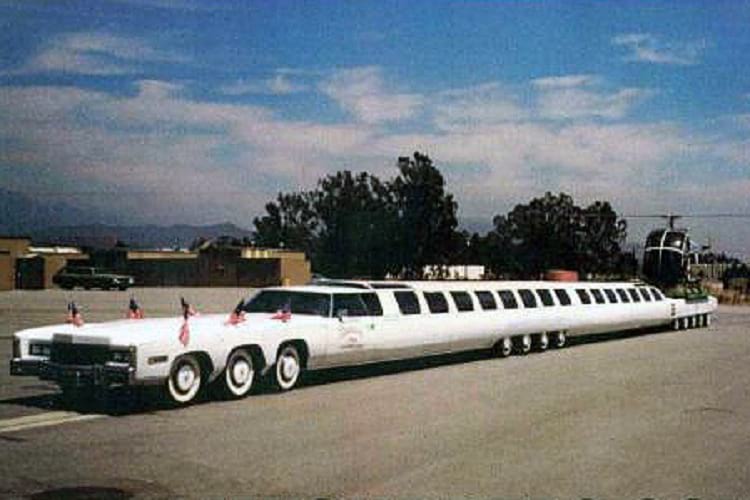
American dream limo. (Courtesy: Jay Ohrberg)
Long ago, when automobiles took to the roads on a commercial basis, they not only made it easier for people to travel from one place to another but it was also a less tiring and more time-saving process. Automobiles became the order of the day and car manufacturers began toying with the idea of bringing changes in the size, shape, design and pattern of the vehicles for more public appeal. Among all the other vehicles that the world had seen, none was as long as the “American Dream”, which was the longest car in the world at one point of time.
History of American Dream limo
Illinois-born Jay Ohrberg, who worked as a truck driver back in the 70’s, was once assigned the task of transporting show cars around North America and Canada for the then five-time American racing champion Craig Breedlove. Jay found out that there was a different set of audience that was in awe of speed cars and had a deep sense of veneration for such vehicles. That fuelled his imagination and gave him the idea of coming up with peculiar designs for building his own show cars. Soon enough he started designing automobiles that were not only strange-looking but were built from things that people would see in their vicinity in their daily lives. His unique car designs were much appreciated by the public, and they brought in the kind of money Jay was looking for, to keep on funding his own designs and custom-making more modified cars and odder-looking designer vehicles.
His stylish cars started to get noticed and eventually Hollywood happened to Jay Ohrberg at the right time. Initially taking it up as a hobby, designing cars for well-known Hollywood production houses became Jay’s passion. The car designer now turned car collector, shifted base to Las Vegas, where he currently owns a shop that deals in such custom-built vehicles. Ohrberg designed a number of automobiles for many popular Hollywood movies and television shows and that prompted him to build a luxury limousine back in the late 80s that would not only go on to stun the world but would also be one of the most unique cars to ever roll.
Specifications of the American Dream
Measuring a whopping one hundred feet in length, the American Dream limo or limousine was built by extensively modifying a golden coloured 1970’s Cadillac Eldorado model, to which more parts were added later on. Ohrberg and his team worked on the sedan by removing its rear seats and working their way by patching up the vehicle with another Cadillac model and joining the two together. Adding twenty-four more wheels, along with its original two front wheels (six in front, eight in the middle and ten at the back), the sedan turned into a 100-feet-long limousine from bumper to bumper. It had seventy-two seats and a host of amenities inside it to boast of. It ran on two motors and had to be driven by two drivers, who had two cabins of their own, one in front and one at the back.
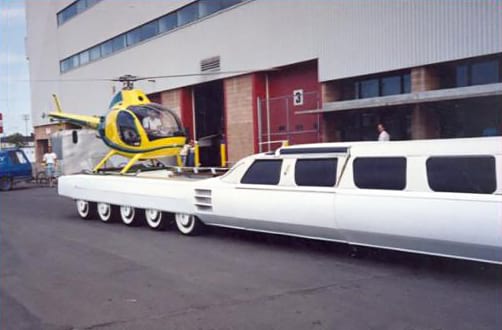
The helipad on the limousine. (Courtesy: Jay Ohrberg)
The American Dream limo interior
When the American Dream limo was complete in the year 1992, it was truly extravagant on the inside. There was a hot tub inside the ultra-luxury car, a putting green (a small part of a golf course), a tanning bed, a plush living room, a Jacuzzi, a swimming pool complete with a diving board, a king-sized water bed, a sun deck, a satellite dish on top and even its own helipad on the backside. A midway detachable panel helped the limousine to be loaded on trailers in two parts in case it needed to be transported from one place to another.

The limousine detached into two parts for being moved. (Courtesy: Jay Ohrberg)
Drawbacks of the American Dream limousine
The comfort car was so long that it could only be driven on a straight path. Owing to its length and its sheer size, it could not negotiate a turn on either side and that is where the two drivers came into picture. It was designed to be detachable in the midsection so that the driver in the back could reverse the vehicle when there was a need for it. Although the car was a limousine, which wasn’t a rare sight in the US, mostly in uptown Hollywood, the American Dream was illegal on the road and did not have permission to be driven publically. It ended up getting leased to a company, which further used the car for promotional purposes.
Last days of the American Dream
After the lease of the luxury limousine ended, it was abandoned in a New Jersey warehouse, where it kept wasting away in solitude in a parking lot. Its body had damaged greatly, windows had been broken, its wheels went missing, its parts had become rusty and moreover, there was no way the car, which once was a rare sight, could be brought back from the brink. Although auctions were held in 2012 to give the car a second chance at life, nothing worthwhile came up due to the damage it had suffered, until two years later when help arrived. In the year 2014, Autoseum Automotive Teaching Museum in New York acquired the American Dream limo, which would help to teach students to build and fix cars that are in such dire conditions.
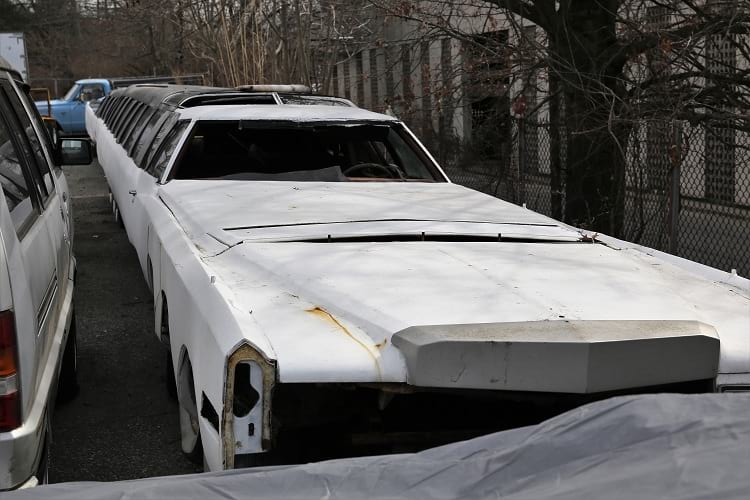
American Dream limousine in 2014. (Vetatur Fumare / Flickr)
While Jay Ohrberg continues to custom-make and design luxury cars and vehicles for movies and put them on display in his museum, there was no way he could save the one piece of his artwork for the world to see. With plans for an even longer limousine, it is still time to see if it actually materializes. The American Dream had a dream run while it was in working condition on the roads, which earned the vehicle a place in the prestigious Guinness Book of World Records. Until Jay Ohrberg designs the longer one as promised, the American Dream limousine will continue to be remembered as the longest car in the world.
Enjoyed this article? Also, check out “Armoured Vehicle-Launched Bridge: A Bridge Over Troubled Water and a Real-Life Transformers“.
Special thanks to Jay Ohrberg for permitting us to use the photos of American Dream limousine.
Fact Analysis:
STSTW Media strives to deliver accurate information through careful research. However, things can go wrong. If you find the above article inaccurate or biased, please let us know at [email protected].
RELATED
The post American Dream Limo: A Long, Luxury Car That Was Once a Rare Sight to Behold appeared first on .
]]>The post Hindenburg: The Tragic Death of World’s Biggest Commercial Airships appeared first on .
]]>
LZ 129 Hindenburg. (Carlos Stein an seine Mutte)

Paul von Hindenburg. (E. Bieber)
At least 84 years after the world’s first airship flew in France; a massive German passenger airship named LZ 129 Hindenburg flew between Europe and both the Americas. During its roughly 14 months service, it completed at least 62 successful transatlantic flights.
LZ 129 was given the name Hindenburg in remembrance of the late Field Marshal Paul von Hindenburg. He was the President of United Germany from 1925 till 1934.
In 1936 alone, LZ 129 Hindenburg carried over 3,500 passengers during 34 transatlantic flights. In addition, it also carried 29937.096 kg of freight and mail.
Nazi government support, funding
In January 1933, when the Nazi Party came to power, two of Hitler’s ministers saw potential in the airship technology. Propaganda Minister Joseph Goebbels gave 2 million marks to Hugo Eckener to speed up the construction of Hindenburg.
Goebbels arch rival was Hermann Göring, who was the commander-in-chief of the Luftwaffe or the German air force, decided to outdo what his rival did. Hermann went on to give another 9 million marks from the Air Ministry’s coffers to the Zeppelin Company.
However, he slapped come conditions. As a result, the Zeppelin Company was split into two firms in March 1935. The two firms were Luftschiffbau Zeppelin and the Deutsche Zeppelin-Reederei (DZR).
The Luftschiffbau Zeppelin was responsible for the construction of airships, while, DZR, which was half-owned by Lufthansa, was responsible for airship operations.
LZ-129 Hindenburg airship was technologically advanced
When completed in 1936, LZ-129 Hindenburg and its sister ship LZ-130 were considered as the biggest commercial airships ever to fly in the world. It was also the most technologically advanced airship of the time. In terms of size, it was as large as four Goodyear Blimps, advertising airships for Goodyear Company. In spite of the airship’s size, it had a cruise speed of 135 kmph (84 mph).

The dining hall of Hindenburg. (Deutsche Rechspost / Wikipedia Commons)

Travellers looking outside the open window from the Hindenburg during a flight. (Nationaal Archief / Flickr)

The lounge area. (German Federal Archives)

Reading room. (SDASM Archives / Flickr)
Nazi authorities use Hindenburg for propaganda
Sensing Hindenburg’s symbolic value, the Nazi authorities initially used the massive airship for propaganda during events like the Nuremberg Party rally.
The first major flight for Hindenburg, after all the test flights, was the roughly 3-day propaganda flight. The flight was to extend support to Adolf Hitler’s bid to remilitarise the Rhineland. In 1936, when German Boxer Max Schmeling defeated American boxer Joe Louis for the first time, Hitler’s government flew him back on Hindenburg.
Interestingly, on March 23, 1936, the airship carried passengers which included 80 reporters on its short flight.
First commercial transatlantic crossing
Days after the various propaganda flights, Hindenburg went on its first commercial transatlantic crossing. The first commercial flight to America had 50 passengers, including journalists, wealthy travellers, Nazi elite and other celebrities. It is also interesting to note that the first ever Catholic mass took place during the transatlantic flight.
The airship is said to have taken two and a half days to reach North America. This was the fastest mode of transport during those days. Apparently, the fastest ocean liners used to complete the same trip in at least five days.
The price of each one-way ticket for the transatlantic flight was $400 during 1936. In 1937, it was $450. The airship also earned money by carrying freight and mail.
Hindenburg disaster
During 1937, of the 18 planned flights, Hindenburg made six successful flights to America and Brazil. Sadly, however, on May 6, 1937, the airship went up in flames and crashed at Lakehurst in New Jersey.

Hindenburg on fire. (Nationaal Archief / Flickr)
At the time of the crash, instead of shepherding in a new age of airship travel, the Hindenburg instead brought an abrupt end to it. In the process, it made the way for the age of commercial aeroplanes.
Experts confirmed that the cause of Hindenburg’s tragedy was due to the igniting of hydrogen lifting gas.
The tragedy put an end to transatlantic airship flights
At the time of the tragedy, Hindenburg was carrying at least 7,062,000 cubic feet of hydrogen payload. When the German passenger airship turned into a fireball on that fateful day, it took the lives of 35 passengers and crew from a total of 91 members. There was also a ground staff member among the dead. This tragedy brought to an end the era of transatlantic passenger flights.
5 other major airship tragedies
Before this, there were five other major airship tragedies. The first one was that of the British R38 in 1921 and that killed 44 people. The next was the US airship Roma in 1922, in which 34 persons died.
The third was the French Dixmude disaster sometime in 1923 and that killed 52 people. The fourth was the British R101 in 1930, in which 48 people were declared dead. The last was the US Akron tragedy in 1933, where 73 had died.
The 804 feet long Hindenburg is the successor to the astoundingly successful airship Graf Zeppelin. Hindenburg’s diameter was 135.1 feet.
Zeppelin was a viable long-range passenger transportation airship during the interwar period, especially during the 1920s. Following its success, Zeppelin Company and Dr Hugo Eckener were keen to build a new fleet of airships that were designed to ferry passengers across the continents.
During the inter-war years, Dr Hugo Eckener was the manager of Luftschiffbau Zeppelin. He was also the commander of Graf Zeppelin.
The Zeppelin Company is said to have purchased at least 5,000 kg of Duralumin from British R-101 wreckage. Duralumin is made of a strong low-density aluminium alloy that is generally used in building an aircraft. The metal was used to fabricate various components for LZ-129 Hindenburg.
Enjoyed this article? Also, check out “The Ghost Blimp L-8 and the Unexplained Disappearance of the Two US Navy Pilots“.
Fact Analysis:
STSTW Media strives to deliver accurate information through careful research. However, things can go wrong. If you find the above article inaccurate or biased, please let us know at [email protected].
RELATED
The post Hindenburg: The Tragic Death of World’s Biggest Commercial Airships appeared first on .
]]>The post RP FLIP: Ship Turned Research Platform which Sinks for a Cause appeared first on .
]]>
RP FLIP partially submerged. (John F. Williams / U.S. Navy)
The RP FLIP (FLoating Instrument Platform) is an oceanographic Research Platform (RP) conceived and built by the Marine Physical Laboratory, it is actually a customized float, not a ship. It is owned by the U.S. Office of Naval Research (ONR) and operated by Scripps Institution of Oceanography, La Jolla, California.
Workings of RP FLIP
RP FLIP is a 355-foot-long drift, having a functional laboratory in front and a hollow metallic extension at the back. When the hollow contains air, FLIP floats on water. When air is replaced with water, then it sinks in water, elevating the front part, the laboratory, by a sharp 90 degrees. The research work goes on uninterrupted in this vertical position. Work over, the float returns to the horizontal position, to be towed to a new location for oceanographic study or surveillance.

RP FLIP in a horizontal position. (Office of Naval Research / Flickr)
Interior and exterior is designed for a radical shift in position
Most of the lab’s compartments have two doors, one for the horizontal, and another for the vertical position. Accessories and equipment are so designed to remain functional in changed orientations. Some fixtures are provided in duplicate so that one remains usable, irrespective of the float position. Others are swivel supported for easy manoeuvrability. Of the 2 bathrooms available on the lab, one functions in vertical, and another in horizontal alignment of the Research Platform.
How was the idea of a floating lab conceived?
Two scientists, Dr Fred Fisher and Dr Fred Spiess wanted to study the nature of sound waves in the depths of sea water. Normal ships move up and down, and sideways, on the restless sea surface. Hence, were unfit for such studies. Search for a serene lab on water surface led to the invention of FLIP in 1962. This lab collects weather-related data, studies sound signals, measures temperature, calibrates wave size and density of seawater on a particular location on the sea surface. In order to keep the RP isolated from interfering sounds, no engine or propulsion mechanism has been installed on RP. It is moved to the water surface with the help of outside force. The RP is so designed that it is steadiest and quietest when in the vertical position.

The ship in a vertical position. (Office of Naval Research / Flickr)
A total of 5 crew members and 11 researchers can remain interned on FLIP for a month. When the float switched from the horizontal to the vertical position, a partition in the horizontal position becomes the deck in the vertical position. On this deck, the lab staff huddles up in the switch-over period. When the change is complete, a five storey laboratory, the 55 feet of RP, is seen standing over the sea surface. The 300 feet of RP remains submerged in the water below. Switch in position is a visual delight, and takes about 28 minutes. As seawater fills into the shaft, it dips into the sea at 90-degree angle, jacking up the laboratory by the same degree over the water surface. In the vertical position, all measuring devices work to their optimum capacity. Therefore, the data picked up is reliable.
Contribution of RP FLIP
The subject matters studied by FLIP include sounds of marine life, heat flow between sea and atmosphere, the formation of storms, the impact of earthquakes, and circulation of water in the ocean bed. RP works in deep (more than 2000 fathoms) as well as shallow waters and isn’t ruffled even by an 80-foot wave. A 30- foot wave causes a meagre 3 feet up-down in the vertical lab. Notably, RP FLIP is one and the only research station of its kind. It was renovated in 1995 and has conducted quality research in the marine milieu. It was rested (dry dockings) 4 times since its launch and completed 50 glorious years in 2012.
Flip to vertical and horizontal positions is easy and smooth
From a functional vertical position to the resting horizontal stance, the switch for RP is the converse of the stand-up operation. To begin with, water in the shaft is removed with the help of compressed air. That makes the shaft light, and moves towards the surface of water till it becomes perfectly horizontal, and emerges out of the water. The research lab at the other end automatically slides down to horizontal position. And once again, we have the float, spoon-shaped, bobbling in seawater.

RP FLIP amid transitioning from horizontal to a vertical position. (Office of Naval Research / Flickr)
Enjoyed this article? Also, check out “CSCL Globe: The Largest Container Vessel in the World, Until MSC Oscar Usurped its Ranking“.
Fact Analysis:
STSTW Media strives to deliver accurate information through careful research. However, things can go wrong. If you find the above article inaccurate or biased, please let us know at [email protected].
RELATED
The post RP FLIP: Ship Turned Research Platform which Sinks for a Cause appeared first on .
]]>The post Maharajas’ Express: An Ultra-Luxury Indian Train That Redefines the Experience of Travelling appeared first on .
]]>
Maharajas’ Express. (Simon Pielow / Flickr)
Train journeys have always held a special place in the heart of people, giving them fond memories to recount. Travelling across villages and cities and watching the lush green countryside and colourful cityscapes roll by, is an exceptional experience for travelers all over the world. But Indian Railways’ Maharajas’ Express is one luxury train that literally goes the extra mile to make sure its patrons have a royal experience of a lifetime on their trip, as the express makes its way through more than twelve choicest destinations in the country.
History of Maharajas’ Express
A joint venture between the public-private organizations of Indian Railway Catering and Tourism Corporation Limited (IRCTC) and Cox and Kings India Ltd. respectively, Maharajas’ Express was started in the year 2010 with a view to boost tourism in North India. The two corporations signed a deal and set up a new company called Royale Indian Rail Tours Ltd., which was to supervise the entire management of Maharajas’ Express. But few months into the partnership and the companies were already running into financial losses, for the business was not very lucrative in its initial days. Cox and Kings India Ltd. had invested a huge sum of money into the venture, while IRCTC claimed that it could bring in more profits if it was given the upper hand in the management duties. This led to a dispute between the two parties and the matter was taken to court.

Maharajas’ Express at a station. (Simon Pielow / Flickr)
Following the Supreme Court orders, it was finally decided that IRCTC would take full charge of the operations of Maharajas’ Express alone and with lowered prices, it would offer the same services as it had promised initially. The contract between the two companies was then terminated a year later in 2011. Ever since, IRCTC took over the operations of Maharajas’ Express and is now being managed exclusively by the Indian Railways, becoming the most expensive luxury train in the world.
Tour Packages of Maharajas’ Express
Depending on the itinerary, the Maharajas’ Express covers several destinations in the country, mostly traversing the northern part of India, centering on Rajasthan. The best part about this train travel is that it allows a traveler to enjoy a royal experience only on wheels. The express generally starts its journey at night and travels to places mentioned on the tour package in a span of nine days at a maximum, which is part of its longer route. The shorter trip package includes only a three-day tour on board the luxury train. Although the train travels through several routes, the one that passengers enjoy the most, not only from India but also from foreign lands, is called the Princely India, wherein the express train journeys through the major cities of the state of Rajasthan.

Maharajas’ Express route map. (Simon Pielow / Flickr)
The package called Indian Panorama includes a tour of the country’s breathtakingly beautiful landscapes starting from Delhi and covering Rajasthan’s Jaipur and Ranthambore and going all the way from Fatehpur Sikri to Varanasi, Lucknow, Agra, Khajuraho and Gwalior. Another route called The Indian Splendour journeys from Delhi and covers Udaipur, Bikaner, Jodhpur and Mumbai, along with Agra, Jaipur and Ranthambore. Other itineraries, which cover almost the same cities, are called The Heritage of India, The Indian Panorama, Treasures of India and Gems of India.
The Southern Sojourn tour package covers Ratnagiri, Goa, Mysuru, Hampi, Trivandrum and Cochin, while the Southern Jewels include a tour of South Indian cities like Chettinad and Mahabalipuram, along with cities from the Southern Sojourn package.
Facilities provided by Maharajas’ Express
With a total of twenty-three luxury coaches, the Maharajas’ Express offers four categories of cabins, including a Presidential Suite, a Junior Suite, a Suite and a Deluxe Cabin. All the coaches are named after precious stones like Heera (diamond), Moti (pearl), Panna (emerald), Pukhraj (topaz), Neelam (sapphire), Firoza (turquoise) etc. The artfully crafted coaches and thematic décor complement the ambience inside each luxurious cabin. Even the details in every cabin, including its color, are such that they match the royal theme perfectly. The Presidential Suite is elegant and very richly decorated, with space enough for two bedrooms and a grand living room too. Out of the twenty-three coaches, one is reserved entirely for the staff and members of the management, which also has a travelling doctor on board in case of any emergency during the course of the journey. One coach can carry at least eighty-eight passengers travelling together.

Junior suite. (Simon Pielow / Flickr)

Lounge of the presidential suite. (Simon Pielow / Flickr)
Amenities inside the Maharajas’ Express
Each cabin measures around 112 square feet and has room enough for a double bed, a foldable writing desk and a luggage storage space underneath the bed, a wardrobe, an electronic safe for personal belongings and an air conditioner. The lavish interiors also have a smoke detection system, CCTV cameras and pneumatic suspension for a smoother journey. The state-of-the-art cabin also provides a plasma television set that plays satellite channels, Wi-Fi facilities, carpeted floors and climate control system to make the journey more memorable. The luxury bathroom in each suite is well-equipped and has a shower cubicle, an elegant bathtub, a water closet and a wash basin with a continuous supply of hot and cold water as per the need. The twenty-four hour valet answers to guests’ calls whenever made.

A bathroom from one of the suite. (Simon Pielow / Flickr)
The coaches also have boutiques, bars and restaurants, which offer nothing less than a five-star dining experience on wheels. The plush lounge bar called The Rajah Club offers an exquisite range of drinks for its patrons. It also offers games tables for a more entertaining and relaxed trip. Comfortable seating arrangements in this luxury lounge, along with corporate bars for meetings on board are also included in the list of amenities on the Maharajas’ Express.

Maharajas’ Express – Bar. (Simon Pielow / Flickr)
A well-equipped kitchen offers an eclectic mix of meals ranging from Indian cuisine to Western dishes. Two restaurants called Mayur Mahal and Rang Mahal offer seating capacities for forty-two guests at a time and serve food from an international platter. All onboard meals are served in the two eateries. Expensive cutlery and tableware adorn each dining table for a more fine dining experience.

Dining at Maharajas’ Express. (Simon Pielow / Flickr)

Cutlery and tableware. (Simon Pielow / Flickr)
Awards received by Maharajas’ Express
While in service since the last nine years, the Maharajas’ Express has added quite a lot of feathers to its already brimming cap. It has been consecutively voted The World’s Leading Luxury Train for five times between the years 2012 to 2017 at the World Travel Awards held in different countries. It won the CNBC Travel Awards in the years 2015 and 2010, and was also adjudged winner of the Seven Stars’ Luxury Hospitality and Lifestyle award in the years 2016 and 2015. It was the first runner-up at the Conde Nast Travellers Readers’ Choice Award in the year 2011 among other recognitions that it has earned since its inception.
The Indian luxury train that charges a whopping fare for a week-long journey to world heritage sites in the country, offering several facilities akin to a stay at an opulent hotel is what makes its tour even more special. Providing a world-class travel experience on wheels, the royal journey on Maharajas’ Express is definitely a once-in-a-lifetime tour one can ever undertake.
Enjoyed this article? Also, check out “The Idea Behind the Rotary Snowplow Train was Conceptualised by a Dentist“.
Special thanks to Simon Pielow, co-founder of The Luxury Train Club for releasing the above images under creative commons.
Fact Analysis:
STSTW Media strives to deliver accurate information through careful research. However, things can go wrong. If you find the above article inaccurate or biased, please let us know at [email protected].
RELATED
The post Maharajas’ Express: An Ultra-Luxury Indian Train That Redefines the Experience of Travelling appeared first on .
]]>The post Lockheed Martin F-22 Raptor: A Fifth-Generation Monster in the Sky appeared first on .
]]>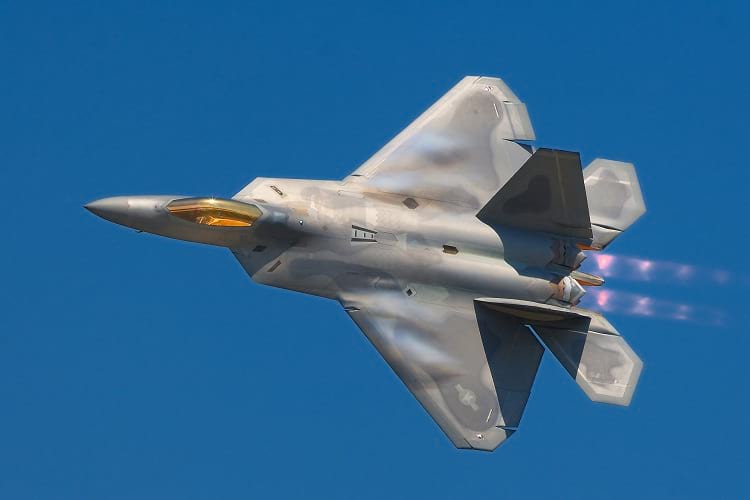
Lockheed Martin F-22 Raptor. (© Rob Shenk / Flickr)
After the recent Pulwama (India) and Balakot (Pakistan) attacks in February this year, three aircraft caught the attention of the whole world. The three aircraft in question are Mirage 2000 multi-role aircraft, U.S.-built F-16 jet and MiG-21 Bison.
India’s MiG-21 Bison is a Russian made supersonic jet fighter that basically functions as an interceptor aircraft. India’s Mirage 2000, manufactured by the French company Dassault Aviation, is a 4th-generation jet designed as a lightweight fighter. Pakistan’s F-16 Fighting Falcon, manufactured by the General Dynamics, is a supersonic multirole fighter aircraft that is designed as a day fighter.
However, there is a far superior jet aircraft than these three, i.e. the Lockheed Martin F-22 Raptor. Most defence experts consider the Raptor F-22 to be a highly advanced fighter having far better air superiority. Lockheed Martin’s mission was to manufacture this fighter with an improved level of stealth, manoeuvrability, speed, avionics and weaponry.
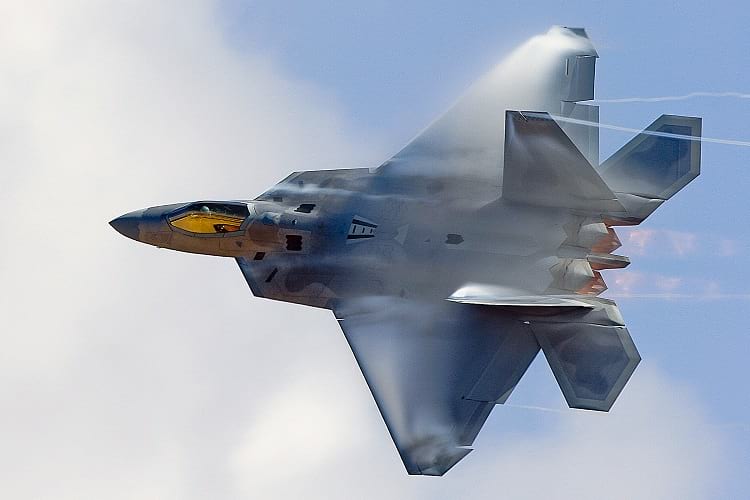
Lockheed Martin F-22 Raptor in action. (Lance Cpl. Dan T. Le / U.S. Marine Corps / Released)
Fifth-generation fighter jet
F-22’s performance has proven its superiority to most other aircraft belonging to any other country. In spite of some naysayers, the Lockheed Martin Raptor F-22 is definitely a monster fighter jet.
The Lockheed Martin Raptor F-22, a fifth-generation fighter jet, integrates computer systems, advanced avionics, networked sensors, and improved stealth functions. Such advancements make this fighter jet suitable for different combat scenarios. Obviously, this is a tough aircraft and it is not easy to defeat it.
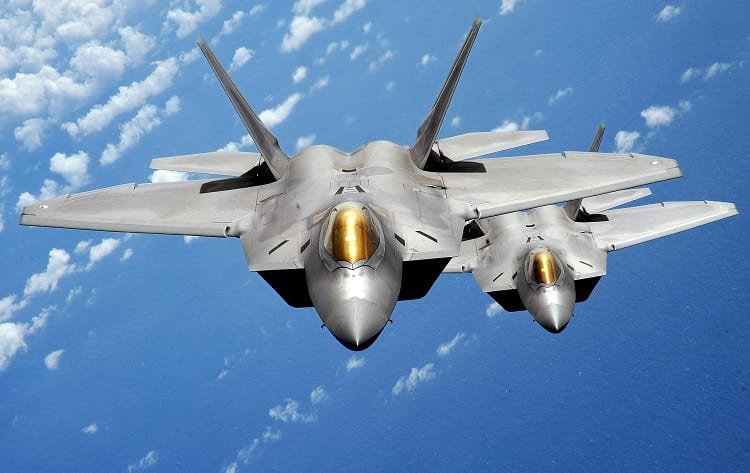
Front view of F-22 Raptor during flight. (Master Sgt. Kevin J. Gruenwald / U.S. Air Force)
Stealth – A unique feature
One of the most impressive attributes of Lockheed Martin Raptor F-22 is the stealth. It is, therefore, difficult for the enemy to detect the aircraft either visually or with the help of radar.
How does the aircraft achieve this attribute? It achieves this capability with the help of Active Electronically Scanned Array (AESA) Radar technology. It also goes undetected with the help of a carefully designed airframe, which minimizes visibility by confusing the enemy radar.
The AESA radar on F-22s is AN/APG-77 of Northrop Grumman. With the help of ‘agile frequency’ beams the radar lets the Lockheed Martin Raptor F-22 to sneak in and out of combat quickly.
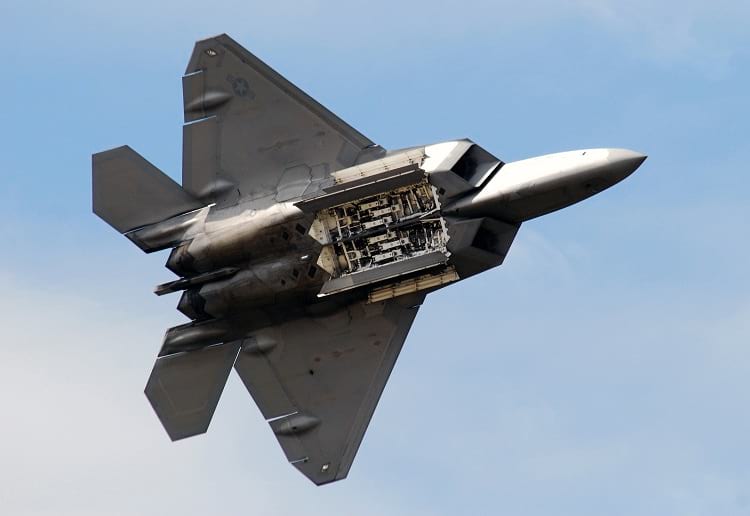
The underside of the F-22. (Edward I. Fagg / U.S. Navy)
Performance of Lockheed Martin F-22 Raptor
The Lockheed Martin Raptor F-22 can fly at supercruise speed with the help of Mach 1 and there is no need for using the afterburners. F-22 is the only aircraft that can fly at supercruise speeds consistently and that too with a full load of weapons. That is because of its Pratt and Whitney F119 engines.

Pratt & Whitney F119 engine. (Wikimedia Commons)
The F119 engines help F-22 to manoeuvre with tight high-g turns and stall tactics without actually stalling the aircraft. Interestingly, F-22 can discharge long-range missiles even at supercruise speeds and also take more time to locate potential targets.
Successful war missions
The F-22 is best at air-to-air combat and surveillance/intelligence gathering tools. It has a kill ratio of 100:0 during air-to-air combat exercises with F-15 Eagle. The aircraft was successfully used in the West Asian war theatre to gather intelligence and give air support to other aircraft.
The F-22 made excellent use of technologies like Synthetic Aperture Radar (SAR) and LINK 16 during the West Asian war missions. In 2014 too, the F-22 successfully completed air-to-ground combat missions against ISIS.
F-22 entered service in 2005
The first Lockheed Martin Raptor F-22 entered into the United States Air Force service in 2005. By 2011, the United States government cancelled the F-22, even though the aircraft was a vital part of the USAF. In 2012, Lockheed is said to have delivered the last F-22 to the USAF. The government, however, cancelled its production due to high maintenance and development costs.
It is interesting to note that per-unit cost of F-22 was $334 million. Though the original requirement of F-22s was 700, there are just 183 F-22 aircraft in the USAF today.
Comparison
In comparison to F-22, the French company Dassault’s multirole fighter Rafale is regarded as the second best fighter aircraft in the world. Because it is the 4.5 generation fighter aircraft in the world.
Meanwhile, McDonnell Douglas F-15 Eagle has been in use for over 35 years by countries like the US, Saudi Arabia, Israel and Japan. It is still considered to be a highly capable fighter. But it is no comparison to F-22.
The only aircraft that can match the capabilities is Sukhoi Su-57 of the Russian firm Sukhoi Company. Sukhoi Su-57, which is expected to enter the Russian Air Force service in 2019, is the first fighter to meet all the features of a fifth-generation fighter.
Enjoyed this article? Also, check out “IAF Mirage 2000: The French-Made Fighter Aircraft that Answers India’s Call of Duty“.
Fact Analysis:
STSTW Media strives to deliver accurate information through careful research. However, things can go wrong. If you find the above article inaccurate or biased, please let us know at [email protected].
RELATED
The post Lockheed Martin F-22 Raptor: A Fifth-Generation Monster in the Sky appeared first on .
]]>The post IAF Mirage 2000: The French-Made Fighter Aircraft that Answers India’s Call of Duty appeared first on .
]]>
Dassault Mirage 2000. (Airwolfhound / Flickr)
The military preparedness of any nation is judged by its loaded arsenal. And if it has the best in its collection to supply to its army, navy and air force, that country no longer lags behind in war. In light of the ghastly terror attack in Kashmir, the Indian Air Force, which recently carried out a surgical strike on Pakistan, is the proud owner of a fleet of aircraft that only some of the superpowers of the world possess. The Mirage 2000, an impressive and deadly aerial beast, is a fighter jet that has come to India’s rescue in all her times of need.
Mirage 2000 in brief
Designed in the late 1970s and manufactured in France by Dassault Aviation, the Mirage 2000 is a multirole combat aircraft, which can perform a wide range of tasks. Right from aerial combats to dropping bombs, long-range missiles at specific targets and also carrying out air-to-ground strikes, the light-weight fighter plane is undoubtedly a force to reckon with. It was initially pressed into service in the French air force in the year 1984 after it took its maiden test flight in the year 1978. In service with nine other countries, including Brazil, Egypt, France, Greece, Peru, Qatar, Taiwan and the UAE, the fleet of Indian Air Force’s Mirage 2000s came to be inducted in the year 1985. Together with the advanced and heavy fighter jets like the Russian-made Sukhoi and MiG-29 and the indigenously-developed Tejas, the aircraft was put into Indian service during the Kargil War of 1999.

Countries that use Mirage 2000. (Wikimedia Commons)
While Pakistan purchased North American-made Lockheed Martin F-16 fighter planes, India went a step ahead and ordered thirty-six single-seater and four twin-seater Mirage 2000s in the year 1982. Since then named ‘Vajra’ from the Sanskrit word for thunderbolt, the Mirage 2000 is an ultra-modern warplane that mostly delivers with hundred per cent accuracy. The aircraft readily served in India’s favour against Pakistan at the line of control in Kashmir.

IAF Mirage-2000. (Tech. Sgt. Keith Brown / U.S. Air Force)
Specifications of Mirage 2000
Despite a dry weight (which includes the weight of crew and passengers, fuel, other necessary fluids and scientific equipment) of around 7,500 kilograms and a maximum takeoff weight (maximum weight at which an aircraft is allowed to make an ascent) of 17,000 kilograms, Mirage 2000 still remains a light-weight aircraft. It measures approximately forty-seven feet in length and has a wingspan of around thirty feet. The delta wings (triangular wings shaped in the Greek alphabet Delta) allow the jet to manoeuver smoothly and maintain its stability mid-air. The IAF Mirage 2000 is available in single or twin-seater options as per the requirement of the air force. The fighter jet with a single-shaft engine can ascend at a maximum speed of 60,000 feet per minute and can reach a maximum speed of 2,335 kmph or Mach 2.2.

The Dassault Mirage 2000 is capable of aerial refuelling. (US Gov)
The Mirage 2000 hits targets with precision and remains the most reliable aircraft in the Indian Air Force. Even the state-of-the-art pilot helmets of Mirage 2000 come equipped with a display inside them. These allow the pilots to see superimposed radar data directly inside, without having to refer to information relayed in the cockpit. This feature enables the pilots to aim weapons at targets by simply turning their heads, without manoeuvering the entire fighter plane in that particular direction.
As many as twelve fighter jets flew into Pakistani airspace recently and the combat aircraft, which also happens to be India’s most preferred war plane, is the country’s trusted aide that thunders in its skies, delivering with a success rate like no other, answering all the calls of duty whenever made.
Enjoyed this article? Also, check out “Hughes H-4 Hercules | The Largest Flying Boat That Flew for Only 26 Seconds“.
Fact Analysis:
STSTW Media strives to deliver accurate information through careful research. However, things can go wrong. If you find the above article inaccurate or biased, please let us know at [email protected]
RELATED
The post IAF Mirage 2000: The French-Made Fighter Aircraft that Answers India’s Call of Duty appeared first on .
]]>The post Was Canada’s VZ-9 Avrocar Flying Saucer the UFOs That Were Seen on Earth? appeared first on .
]]>
Avro Canada VZ-9 Avrocar. (U.S. Air Force photo)
Aliens landing on earth in a flying saucer and then zooming off is one idea which is part of science fiction as well as informed debates. Is there some truth in the stories of the flying saucers, also called Unidentified Flying Objects (UFOs)? Or, is it just human imagination, a pure fiction? Or, could it have something to do with defence research carried out by America in utmost secrecy? Avro Canada VZ-9 Avrocar, Canada’s Flying Saucer, gives us a sneak-peek into these questions.
Avro Canada VZ-9 Avrocar manufacturing begins

John Carver Meadows Frost, the designer of Avro Canada VZ-9 Avrocar in his lab. (Bzuk / Wikimedia Commons)
The idea of a supersonic aircraft with a circular wing in the periphery of a saucer-like main body was conceived by Avro Aircraft Canada in 1952. The aircraft was designed to land and take off vertically with the help of a circular Turborotor powered by turbojet engines. Canadian Defence Research funded this project to the tune of $400,000 (₹2.8 crore). The air thrust generated by jet engines propelled the aircraft. Directing the thrust downwards create ‘ground effect’ which make it float in the air at low altitude. Directing thrust to the rear made saucer travel forward. Jack Frost, the team leader of the project, was convinced that Canada’s Flying Saucer would qualify for Short Take Off and Landing (STOL) as well as to supersonic speed.
America steps in to collaborate with Canada
But the road ahead was difficult. Just 2 years into the project, the Canadian Government abandoned it, saying it was too expensive to be sustained. Fortunately, by then the United States Air Force (USAF) came to know about the project and found it promising for their specific requirements. Those were the days of the Cold War, and the US was ambitious regarding Vertical Take Off and Landing (VTOL) aircraft for its Air Bases. Hence, in 1955, USAF signed a contract for $750,000 (₹5.25 crore) to revive this project. The project progressed well and more than $250,000 (₹1.75 crore) were ploughed into it till March 1957. This entire exercise was kept a closely guarded secret till July 1960.

VZ-9 Avrocar during flight test. (U.S. Air Force photo)
Avrocar project fails to meet American expectations

The first Avrocar at Avro factory. (Bzuk / Wikimedia Commons)
US Army and Air Force had different expectations from the prospective aircraft. The Army wanted a subsonic, all-terrain, transport and reconnaissance plane. Air Force, on the other hand, wanted a VTOL jet, which could dodge enemy radar by flying at low altitude and then run away at supersonic speed. The twin objectives were sought to be achieved by application of the Coanda Effect based on the principle that when a moving fluid, such as air or water, comes into contact with a curved surface, it will try to follow that surface. A saucer-shaped main body with a circular wing could exploit the Coanda Effect to the hilt. Small shutters on the edge of flying saucer could direct the direction of the aerial journey. On this premise, 2 small test vehicles, named VZ-9AV (experimental vertical flight for the 9th concept proposal from Avro) were built in the year 1958. Unfortunately, these test vehicles failed the flying test. Supersonic speed couldn’t be reached. A few feet into the air and the saucer wobbled uncontrollably (Hubcapping). A maximum altitude of 3 feet and a speed of 35mph was all the test vehicles could achieve.
US Army and Airforce then undertook to develop the air vehicle in a top secret black project.

Labelled drawing of the major components of the Avro Canada VZ-9 Avrocar. (U.S. Air Force photo)
Avrocar project was closed, but the research yielded collateral gains
The Project was wound up in 1961 when problems observed in test conditions couldn’t be eliminated. However, leads from the project found application in diverse fields of research and development.’Ground effect’ produced at take-off and landing was used by Bell Aerospace in 1963 for ‘Advanced Cardiac Life Support’. Prototypes of Boeing YC-14 and McDonnell Douglas YC-15 (both are short take-off and landing tactical military aircraft) were also based on Avrocar studies.
Was America hiding something?
Of the two Avrocar models manufactured and tested, one is kept at the US Army Transportation Museum in Virginia and another at the National Museum of the United States Air Force in Dayton, Ohio. But this, surely, is not the end of the story.

Avro Canada VZ-9 Avrocar at the National Museum of the United States Air Force. (U.S. Air Force photo)
There are indications that the US Air Force, in collaboration with Avro Canada had already built a supersonic flying saucer in 1956. One declassified memo talks about a flying saucer which could travel 2,300-3,000 mph over a height of 1 lakh feet and cover a distance of 1850 Km.
The US government, it appears, was secretly working on a flying saucer project since 1940. This is proved by ‘Roswell UFO Incident’ which happened in the summer of 1947. An unidentified debris was found in Roswell, New Mexico, which the local Air force base dismissed as a crashed weather balloon. But people weren’t convinced. The debris was widely described as a crashed flying disc and the official version to the contrary was seen as a cover up exercise. Officials of the nearby Roswell Army whisking away the crashed fuselage promptly and surreptitiously was also viewed as a cover up.
Unidentified flying object (UFOs) may well have been the secret trials of Avrocars by America
A series of flying disc accidents reported in the fifties further reinforced the perception that it was some kind of a secret American Experiment. When the story of the mysterious UFOs broke some 50 years later, US military explained it as part of top-secret atomic espionage project called Project Mogul. But the explanation was too little and too late. America’s ‘top secret black project’, or something like it, probably existed even before the idea of flying saucers was conceived by Avro Aircraft Canada. The US collaborating with Canada, it seems, was a carefully thought out American agenda. The US, ostensibly, was already in the making of such flying machine and partnered Canada for business. Hence it is difficult to believe the official version that the Avrocar project closed down as a failure.
Enjoyed this article? Also, check out “Convair NB-36H: The only American Aircraft to Carry an Operational Nuclear Reactor“.
Recommended Visit:
1. US Army Transportation Museum | Virginia, USA
2. National Museum of the United States Air Force | Ohio, USA
Fact Analysis:
STSTW Media strives to deliver accurate information through careful research. However, things can go wrong. If you find the above article inaccurate or biased, please let us know at [email protected].
RELATED
The post Was Canada’s VZ-9 Avrocar Flying Saucer the UFOs That Were Seen on Earth? appeared first on .
]]>The post CSCL Globe: The Largest Container Vessel in the World, Until MSC Oscar Usurped its Ranking appeared first on .
]]>
CSCL Globe at Port of Felixstowe, UK. (Keith / Flickr)
A container ship called MV CSCL Globe had the privilege of holding the record for the largest container ship in the world but only for a short number of days. It was manufactured by a South Korean company called Hyundai Heavy Industries and operated by a company in China called China Shipping Container Lines (CSCL) which was later taken over by COSCO Shipping Development Company. The home port of this ship is in Hong Kong.
The CSCL Globe was the first of five identical ships that were created for Asia-Europe trade routes. It cost CSCL USD 700 million to make all 5 of them.

CSCL Globe in Hamburg, Germany. (Walter Rademacher / Wikimedia Commons)
CSCL Globe: Route of the ship
Considering dimensions, this ship is more than 400 meters long, 58.6 meters wide and 73 meters tall. The length of this ship can be equated to a little more than 4 football pitches. The ship also weighs more than 186,000 tonnes. The engine of the ship, which is over 17 meters high, has also broken a world record of being the largest engine ever built. Just for clarity, this record is in terms of size and not power.
The CSCL Globe started her journey in Qingdao, China on 3rd December 2014. Her first stop was a port in England called Felixstowe. On her route, she also stopped at ports in Singapore, Malaysia, Egypt, UK, Germany, and Belgium. Her last stop was back at Ningbo in China on February 25, 2015. It is interesting to note that only 28 people work aboard the ship. They usually spend most of their time in the sauna or the gym, sometimes going up to the crates to make sure everything is alright. It takes about 1 day to load and unload the cargo, and thankfully the crew can leave the task up to the port duty.

CSCL Globe. (Frank Schwichtenberg / Wikimedia Commons)
The capacity of the CSCL Globe
Construction of the ship started in May 2014; by October the ship had completed its sea tests and was ready to launch in November 2014. At the time of its launch, it was certainly the largest container ship in the world that could hold 19,100 standard containers of 20 ft length. The CSCL Globe was able to hold this record only for the next two months till January 2015 when the MSC Oscar container ship was launched. It could hold 19,224 containers. It is important to note that the CSCL Globe itself had superceded the Triple – E which could carry only 18,200 containers.

MSC Oscar container ship. (Frans Berkelaar / Wikimedia Commons)
However, if we compare the numbers from 18 years ago in 1996 which is when the first container ship was launched, we’d be surprised to see a jump of almost triple the capacity. The ship in 1996 could only carry 6000 containers. Although, there is an ongoing debate about the growth in capacity of these ships. The shipping lanes in Europe and Asia are the only ones that can accommodate container ships with a capacity of 18,000 to 20,000 containers. The lanes in America can’t handle these yet. Ships beyond 22,000 containers will definitely create a problem for both Europe and America. It’s important to ask the question, when is the largest shipping container going to be large enough to meet all our growing needs.
Enjoyed this article? Also, check out “Seawise Giant: The Enormous Vessel That Remains the Biggest Man-Made Ship Ever Built“.
Fact Analysis:
STSTW Media strives to deliver accurate information through careful research. However, things can go wrong. If you find the above article inaccurate or biased, please let us know at [email protected].
RELATED
The post CSCL Globe: The Largest Container Vessel in the World, Until MSC Oscar Usurped its Ranking appeared first on .
]]>The post Aerial Refuelling: The Inspiring Account of the KC-135 Stratotanker Military Aircraft appeared first on .
]]>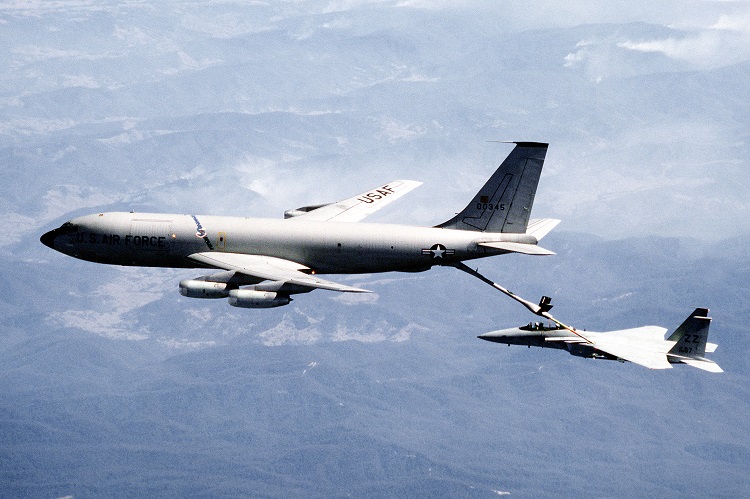
KC-135 Stratotanker refuelling F-15 A Eagle fighter aircraft. (TSGT Curt Eddings / The U.S. National Archives)
The Boeing KC-135 Stratotanker is a pioneering military aircraft that has the primary function of aerial refuelling. The aircraft was developed from the prototype of Boeing 367-80.
From 1957 to 1965, Boeing created nearly 732 KC-135 Stratotankers customized for use by the US Air Force. Initially, they were purposefully exploited to refuel strategic bombers.
The aircraft was widely used during the Vietnam War. Much later, it found its application in the Operation Desert Storm of the Gulf war. It was utilized to increase the range and resilience of the US fighter planes and tactical bombers.
Aerial refuelling strategies of the KC-135 Stratotanker
The tanker’s flying boom is the aircraft’s fuel transfer entry point. There is a fuel inflow operator situated at the backside of the fuselage. US Air Force have mainly used a boom and receptacle fuel refilling method.

Fuel operator in KC-135. (John E. Lasky / United States Air Force)
In addition, behind the boom, you can find a shuttlecock drogue as a trailing object. The drogue comes to play for refuelling aircraft that are fitted with probes. Aircraft equipped with drogue cannot be used for refuelling the boom and receptacle variety.
There are around forty-five KC-135R Stratotankers that are integrated with wingtip hose and drogue components or pods for air refuelling. They are used for refuelling aircraft for Navy and NATO. They do not use the boom and receptacle technique. When the receptor aircraft need a refuelling, it approaches the tanker of the donor KC-135. The probe of the tanker connects with a hose that reels out from the trailing end of the tanker thereby supplying the fuel.
Service history
Sometime close to the 1957s, the KC-135 was first purchased by the Strategic Air Command (SAC) to support their bomber aircraft. Between 1957 and 1992, the Stratotanker continued its service with SAC, primarily with its constituent units Air National Guard and the Air Force Reserve.

KC-135 Stratotanker preparing to refuel Boeing B-52D strategic bomber. (US. Government)
In 1992, in the wake of a major US Air Force restructuring that saw the cessation of SAC, most of the KC-135s being reallocated to the just recently formed body Air Mobility Command (AMC).
As of May 2014, AMC operates and manages 414 numbers of KC-135 Stratotankers out of which 247 aircraft is flown by ANG and AFRC as part of AMC’s mission and strategy.
Application to research
The KC-135, in addition to its chief function as an aircraft refueller, was also used in various research programs. It was designated as NKC-135. It has assisted NASA at their Dryden Flight Research Centre, California.

Super Stallion heavy-lift helicopter approaching the refuelling pod for aerial refuelling. (DVIDSHUB / Helicopter Air Refuelling Mission)
From 1979 to 1980, the aircraft’s service was utilized to design and develop winglets. Winglets are tiny and upright fins that are positioned at the tips of the aircraft wings. With the incorporation of winglets, the range of the aircraft was significantly increased. They also resulted in a drastic reduction in the drag.
Various KC-135 aircraft were also used by NASA without the tanker to serve as their eminent gravity-defying simulator Vomit Comet aircraft.
Modernisation with full-glass cockpit
The US Air Force authorized Rockwell Collins to spearhead and conduct the modernisation program of the KC-135 avionics system. The project was named KC-135 Pacer CRAG that included revamps of the Compass, Radar, and the Global Positioning System (CRAG).
In 2017, an upgraded version with Block 45 standard of KC-135R was launched. In this upgraded configuration, the tanker has cockpits completely made up of glass. It also consolidates a large and precise centrally placed digital display, reconditioned altimeters, digitally controlled flight directors, autopilots, and different customized computer units.
The Block 45 redesign depends tremendously on economically available frameworks to both lessen the cost and aggrandize the modification procedure. The adjustments make the aircraft more secure and reliable. In addition, they simply offer a decent opportunity to supplant outdated gear.
In particular, the enhanced KC-135s can associate flawlessly with civil navigation and aviation traffic control arrangements all across the world. Safely and seamlessly, it enables them to fly through civilian and military airspace alike with no undue danger of mishaps. The digital computer modules permit the ground crew to effortlessly introduce software updates to make the systems stay up with the latest, as well.
Over and above, the newness in the system allows the aircraft to assume control over a portion of the manual work that the KC-135 crews used to perform. The overhauled equipment likewise gives more precise maintenance alerts and information, accelerating the repair procedure if some fault is reported.
Performance
The KC-135 Stratotanker can propel at a climbing rate of 1,490 metres per minute. The maximum speed is 933km per hour and the cruise speed is 852km per hour. The maximum range of the aircraft is 2,419km. As part of its cargo handling capacity, the aircraft can carry passengers and freight weighing close to 37,650kg. The aircraft weighs an approximate 44,663kg.
Accounts of use during major wars
The Vietnam War that continued for nine years saw the use of KC-135s making 813,000 numbers of on-air refuelling of the combat aircraft. Also during the course of the Persian Gulf War, the tankers were reported to have made an approximate 18,700 number of hook-ups and a transfer of nearly 126 million kilograms of fuel.

Royal Air Force Tornado GR4 aerial refuelling in progress at the rate of 500 litres/minute. (Cpl Graham Taylor RAF / MOD)
Replacement of the KC-135 aircraft
According to reports from the US Air Force, the E and R variants of KC-135 have a maximum flying lifetime of 36,000 and 39,000 hours respectively. It was predicted that by 2040, only a few aircraft would clock these limits.
By that time, these aircraft are anticipated to be almost 80 years old. Currently, both the models have only 33% of flying lifetime remaining in them. From 1993 to 2003, the maintenance cost and the renovation cost doubled and trebled proportionately in that order.
In 2009, the US Air Force took the final decision to replace the fleet of their KC-135. In February 2011, Boeing officially announced receiving a contract from the U.S. Air Force to build the KC-46, the next-generation refuelling aircraft that were likely to replace 179 numbers of the aggregate of 400 tankers of KC-135 aircraft.

Aerial refuelling compatibility tests of the new Boeing KC-46. (Christopher Okula / U.S. Air Force)
Variants of KC-135 Stratotanker
The numerous models of KC-135 Stratotanker are listed below.
1. KC-135A – The original version equipped with Pratt & Whitney J57S turbojet engines.
2. NKC-135A – Test variant of KC-135A
3. KC-135B – Fitted with turbofan engines, this aircraft is primarily an airborne command post variant. EC-135C is the redesignated version of KC-135B
4. KC-135D – Similar to the KC-135A, but, only with the difference that they are powered by Pratt & Whitney TF33 engines and with a modified flight engineer’s position on the deck.
5. KC-135E – They are designed with Pratt & Whitney TF-33-PW-102 engines. They were operated by the Air Force Reserve and Air National Guard. They retired from their service in September 2009
6. NKC-135E – Test model of KC-135E
7.VKC-135Q – Reconditioned version of KC-135A designed in compatibility to carrying JP-7 fuel that powered SR-71 Blackbird aircraft.
8. KC-135R–Original KC-135R version produced in 1960. They were fitted with Pratt & Whitney J57 turbojet engines and redesigned from the KC-135As. They were used for reconnaissance and assessment of on-ground nuclear tests. Later some KC-135As KC-135Es were renovated with CFM-56 engines. The approximate number of conversions is 361.
9. KC-135R (RT) – Variant of KC-135R endowed with receiver capability.
10. KC-135T – Modified version of KC-135Q integrated with CFM-56 engines.
11. KC-135Y – Equipped with Pratt & Whitney TF-33-PW-102 turbofan engines. Modified in 1984, it served as an airborne command post. Currently, it has retired.
Enjoyed this article? Also, check out “Convair NB-36H: The only American Aircraft to Carry an Operational Nuclear Reactor“.
Fact Analysis:
STSTW Media strives to deliver accurate information through careful research. However, things can go wrong. If you find the above article inaccurate or biased, please let us know at [email protected].
RELATED
The post Aerial Refuelling: The Inspiring Account of the KC-135 Stratotanker Military Aircraft appeared first on .
]]>The post F-82 Twin Mustang Aircraft – The Dual Cockpit Fighter of the Forties appeared first on .
]]>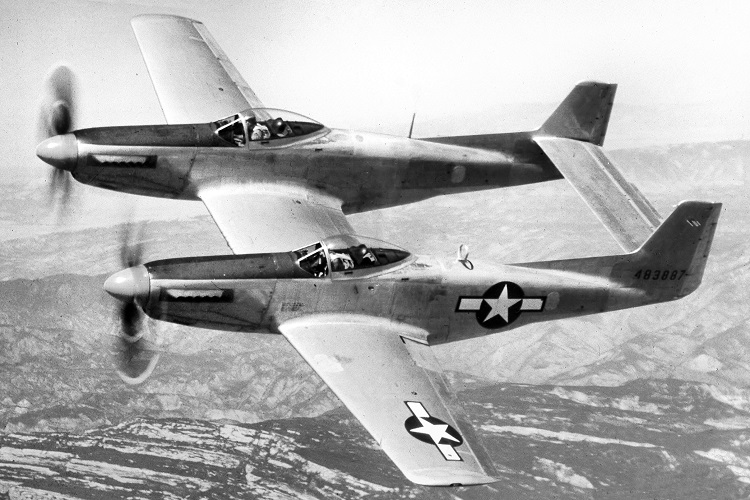
North American XP-82 Twin Mustang prototype during a test flight over Sierra Nevada. (U.S. Air Force)
The entry of America in World War II happened by default, and at a late stage, but the continent went whole hog into it. Its military preparedness went much ahead of the war itself. A fleet of P-82 Twin Mustang Aircraft (later called F-82 Twin Mustang) was still in the process of manufacturing as curtains came down on World War II, the very event for which this fleet of fighter aircraft was being made.
That’s in line with the ethos of military preparedness; better be over-prepared than less. F-82 indeed is a chapter on how to gear up for war. North American F-82 Twin Mustang was designed in 1943 for back up support to bomber aircraft. It could fly 2,574 km fully loaded, even more, when equipped with auxiliary fuel tanks (drop tanks).
Construction and production of F-82 Twin Mustang
Its massive frame looked like two P-51 airplanes joined with a common wing, and tails connected with a horizontal plate. It was designed to give multi-layered protection to fighter planes while on a deep strike mission. First twenty rollouts of this aircraft had two cockpits for two pilots who could alternate controls on ultra-long-range missions to overcome fatigue.

Front view of the Twin Mustang. (U.S. Air Force photo)
The cockpit on the left side controlled flight and engine power, and cockpit on the right side controlled relief and emergency work. Aircrafts manufactured subsequently carried only one cockpit. The other cockpit was replaced by a dedicated radar operator.
Its jumbo size notwithstanding, F-82 was agile enough to dodge and dogfight the enemy fighter planes. Power of Rolls Royce Merlin engines gave it a top speed of 750Km/hour. Six machine guns of 0.50 calibre mounted on the central wing, and ability to carry an additional load of 25 air to ground rockets or up to 4,000 pounds (approx 1800 kg) of bombs on the hardpoints in outer wings, made it a real scare with the epithet ‘Double Trouble’.

XF-82 Twin Mustang preparing for a test flight. (Rodney Grubbs / NASA)
Application after the Second World War
World War II ended well before the launch of P-82. But as the cold war between America and Russia was very much rife, this fighter plane remained relevant even after the World War. Transition to jet engines would still take time and there had to be a time gap arrangement for wartime exigencies. So the Pentagon placed the order for P-82 Twin Mustang, the last of Piston-Engine aircraft.
It was re-designated as F-82 and commissioned into SAC (Strategic Air Command) as a fighter escort for long-range strikes. The radar edition of it safeguarded US coasts from the Russian bombers like Tu-4 Bull.

Colour photo of North American Twin Mustang. (U.S. Air Force photo)
Twin Mustangs were the first Allied warplanes to counter the Communist invasion of South Korea in 1950. Within hours of the North Korean invasion, F-82s were flying over the Korean borders. They not only drove enemy aircraft out but also destroyed three of them clinching first air-to-air victory. Combat missions of F-82 continued in Korea for the following two years.
By 1951 jet engines arrived on scene and piston engines were pushed to the margin. Some variants of F- 82 continued flying till November 1953. As of now, only five of these, from a total of 272 manufactured units remain conserved in museums and warehouse.
Death and restoration of Twin Mustang
The most innovative product in the series of P-51 and Mustang, P-82/F-82 finally bowed out to jet-engine technology. To counter fatigue during long flights the cockpit was modified and a tilt-adjustable seat was introduced. A versatile flyer, fighter, long-range escort, attack bomber, night fighter, long-range reconnaissance aircraft, rocket fighter and interceptor, F-82 Twin Mustang is now history.
This history though is revved up by Tom Reilly, the famed for the restorer of trashed aircraft. He procured a prototype for Twin Mustang and went about resurrecting F-82 in its pristine form through his intensive ‘restoration’ project. The prototype was of early P-82 with dual control (two cockpits and two pilots).
Reilly’s dedicated search led him to a crashed F-82 in Alaska. Next breakthrough was finding a brand new Merlin engine in Mexico City. With help pooled in from myriad sources, Tom and his crew have sculpted XP-82, a reborn F-82. Now, one can hope not only to see and feel the history but, very possibly, fly in it as well.
Enjoyed this article? Also, check out “Why NASA Loves the Super Guppy Aircraft?“.
Recommended Visit:
National Museum of the United States Air Force | Ohio, USA
Fact Analysis:
STSTW Media strives to deliver accurate information through careful research. However, things can go wrong. If you find the above article inaccurate or biased, please let us know at [email protected].
RELATED
The post F-82 Twin Mustang Aircraft – The Dual Cockpit Fighter of the Forties appeared first on .
]]>The post Super-Trains of the Past: Trains with Jet Engine appeared first on .
]]>
Super-Trains: A train fitted with jet engines. (Tekhnika Molodezhi / Wikimedia Commons)
Humans have always been fascinated by speed. Since the invention of the wheel, we have been constantly trying to make it go as fast as it can. During the era of cold war, the two superpowers, the US and the USSR went head to head in building the best (i.e. the fastest) ‘Turbojet Train’. After the end of Second World War, US and USSR had been competing against each other to acquire the title of ‘superpower.’ This rivalry was expressed in terms of military superiority, political clout, economic power and technological advancement.
The inception of the super-trains
During the 1960s, the idea of powering a train with a jet engine came into the minds of scientists. This project offered wide possibilities for developing high-speed railway network in future. While there still is conflict about who invented the idea, the first train with turbojet engine A.K.A ‘Turbojet Train’ was made by ‘New York Central Railroad’ in 1966. Known as the ‘M-497’, the train was fitted with a jet pod from “Convair B-36 Peacemaker” bomber. The pod comprised of the two “J47-GE-19” jet engines. This pod was acquired from Davis-Monthan Air Force Base situated in Arizona for $5000. Initially, the turbojet engine was to be mounted in the rear of the railcar. Later, the design was changed to have it on the front.
A 111-kilometre section of straight, multiple tracks between Toledo, Ohio, and Indiana was used for the high-speed tests. An aeroplane flew ahead of the train to make sure that the track was clear and railroad ties were placed along the track in case the railcar derailed during the trail. The M-497 recorded a speed of 295.88 km/h. The M-497 was used for various purposes including snow clearing until 1977. It met its end in 1984 when it was scrapped.
Russian version of the super train
A similar development took place in USSR in 1970, when one of the ER22 head engines was modified by adding two turbojet engines. The objective of the railcar was to hit about 260 km/h. The tests were conducted on railroad terminal in Golutvin. In the first attempt, it touched a speed of about 186 kmph. In the second attempt, the engines were pushed to the maximum limit achieving a speed of 250 kmph. The Russian version of the turbojet train met a similar fate and now lies abandoned, rusting in back of a rail car factory in Doroshikha.
A model of this great piece of art and technology stands in a rail factory in Tver. These super-train projects, which could have been the means of transportation in the future, were dropped due to several reasons. First of all, these projects were not economically viable, they, in fact, consumed more fuel than the jets. Secondly, the jet engine could only move the train in the forward direction, this implied that several huge modifications had to be made. Thirdly, people were afraid of such projects, they considered the idea to be too unreliable and feared that even a minor defect in railway track would have disastrous consequences.
Enjoyed this article? Also, check out “The Idea Behind the Rotary Snowplow Train was Conceptualised by a Dentist“.
Fact Analysis:
STSTW Media strives to deliver accurate information through careful research. However, things can go wrong. If you find the above article inaccurate or biased, please let us know at [email protected].
RELATED
The post Super-Trains of the Past: Trains with Jet Engine appeared first on .
]]>The post Mine Flail: Triggering Mines to Ensure Safety appeared first on .
]]>
A mine flail mounted Sherman Crab Mk II in action. (Mapham J (Sgt) / Imperial War Museums)
When we talk about wars and terrorism, we focus on guns, bombs and tanks. We tend to forget the roguish killer that has claimed millions of lives and can be made for a mere price of three dollars – Landmines. Landmine is an explosive that is triggered by pressure or by remote. Throughout the course of history, landmines have been used by countries all around the world to attain military goals.
It is estimated that there are 110 million landmines buried in the ground right now. Landmines can stay active for more than 50 years and therefore pose a real threat to the people. Moreover, minesweeping and neutralizing operations are expensive, costing anywhere between 300 to 1000 US dollars per mine. The rate tends to be higher for developing countries.
History of mine flail
Various demining techniques have been developed since the first world war, but ‘mine flailing’ remains the most eccentric one. In this technique, a device named ‘mine flail’ is attached to the vehicle. The device consists of a rotor to which heavy chains with flails (small steel balls) are attached. The attachment helps mine clearance by intentionally triggering and detonating them. The rotor is mounted in front of the vehicle with the help of two metal arms. The rotor rotates rapidly and swings the flails into the ground generating forces similar to that of footsteps.
This triggers and neutralizes the mines while doing a minimum level of damage to the vehicle. In ideal conditions, mine flailing can successfully demine the land to an extent of 100 percent. This approach to mine clearance was first adopted by the British during the second world war. The British came across the problem of landmines twice. For the first time when Hitler threatened to invade the United Kingdom. As a precautionary measure, Britain had buried over 350,000 landmines across the beaches to prevent Nazi invasion. When Hitler changed his mind, these mines had to be removed.
They faced the same problem for the second time when the allied forces were advancing towards Germany. During the war, mines, specifically, landmines formed the backbone of the German offence and defence. Germans used landmines to block paths, divert and slow down advancing allied troops. But if the troops somehow managed to cross the deadly minefields without any casualties, they could easily flank the enemy.

Mine flail mounted on valentine (tank). (UK Gov / Wikimedia Commons)
Other prototypes
As a result, the development of mine flails took place. In 1942, ‘Matilda Scorpion’ was developed. This was a modified Matilda tank fitted with a mine flail. The flails were powered by a secondary V8 Ford engine. Twenty-five of such Scorpions helped the Allied forces to cross the fields near El Alamein (referred as the ‘Devil’s Garden’) which had almost 3 million landmines.
The process was quite tedious and slow. The tank had to clear mines under the fire of German gunners. However, the flails managed to create a screen of dust that obstructed the German line of sight. The crew had to wear a gas mask in order to breath. The performance of the tank was not on par with the expectations, the flails broke down and the engine failed occasionally. However, the tank managed to do the work.

Close up of modified Matilda scorpion tank in operation. (No 2 Army Film & Photographic Unit, Whicker (Lt) / Imperial War Museums)
After the battle of El Alamein, the technology was further developed and several flail tanks were made, the most notable one being “the Crab” which was a modified Sherman tank. Several innovative developments were made in this flail tank. It had chains modified to cut barbed wires and used chalk to mark the lane swept clear of mines.
Also, the flails were powered by the tank’s engine itself. However, the process of mine clearing was still very slow as ‘The Crab’ could move at a speed of only 2 kmph while flailing. Also, the tank could not fire at the enemy as the main turret had to point backwards while flailing. Sherman Crabs, today, are displayed in museums across the globe, including Canada, Netherlands, India, and England.
Mine flails are still in use. They are used in third world countries where major landmass is affected by landmines buried years ago. However, the purpose of operation has changed entirely from war to humanitarian purpose. The vehicles are unarmed and yield only the amour necessary to withstand the blast.
Now, ‘Mine flails’ are not exclusive to the tanks, they are also mounted to trucks and remote-controlled armoured cabs. It still is the most rapid mine clearing method but, really expensive to operate. Also, it doesn’t yield a 100 percent success rate every time. UN has set the safety criteria as 99.4%, but mine flails sometimes clear only 50-60 percent of the mines.
Recommended Visit:
Base Borden Military Museum | Canada
Fact Analysis:
STSTW Media strives to deliver accurate information through careful research. However, things can go wrong. If you find the above article inaccurate or biased, please let us know at [email protected].
RELATED
The post Mine Flail: Triggering Mines to Ensure Safety appeared first on .
]]>The post Hughes H-4 Hercules | The Largest Flying Boat That Flew for Only 26 Seconds appeared first on .
]]>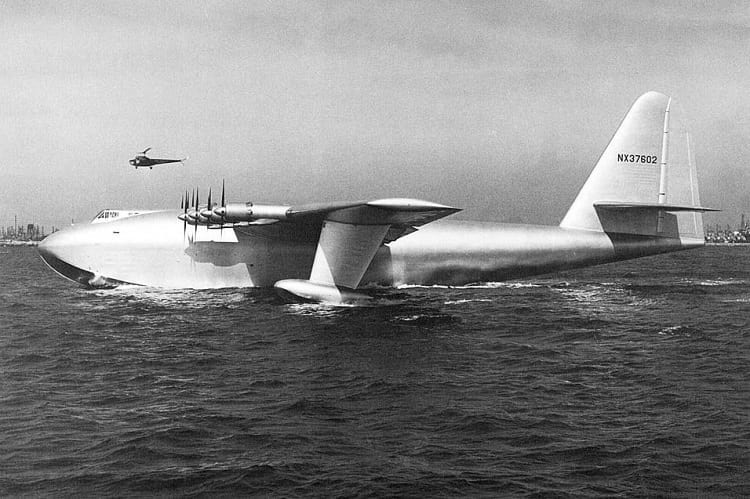
Hughes H-4 Hercules during the test flight. (Federal Aviation Administration / Wikimedia Commons)
Deemed as the world’s biggest flying boat that has ever been made, Hughes H-4 Hercules now stands for display inside the Evergreen Aviation & Space Museum in McMinnville, Oregon, United States. Also known as Spruce Goose – the strategic cargo flying boat only flew once in its lifetime.
It was at the time of World War II that US government had commissioned to have a flying boat built that would facilitate the transportation of war material and personnel to Britain. Allied ships were attacked by Germans and hence, they needed an aircraft to make their way across the Atlantic Ocean, without being raided by German soldiers.
The flying ship was the brainchild of a shipbuilder, Henry J Kaiser. But since he was a ship manufacturer and had no knowledge of how to build an aircraft, he approached Howard Hughes, of Hughes Aircraft Company.
Development of Hughes H-4 Hercules
In 1942, the order to have three such aircrafts developed within two years was placed by the government and Kaiser. Soon, Hughes and his designer Glenn Odekirk began working on it. Since it was wartime, strategic material like aluminium was not available, so the aircraft was made entirely out of birch wood with its rudder and elevator made out of fabric.
The development moved at a slow pace, partly because of limitations in availability of metal and partly because of Hughes’s perfectionist attitude. The very first HK-1’s construction took about 16 months, which irked Kaiser and he withdrew himself from the project.

Aerial view of H4-Hercules during construction. (Robert G. Swan / U.S.Gov)
After Kaiser’s exit, Hughes continued the project and titled it, H-4 Hercules. This time the government signed on completion of a single unit. The work pace was still slow and the cargo flying aircraft was only completed much after the war was over, hence not serving the purpose for which it was built in the first place.
Hughes completed his work on the aircraft at Hughes Airport (that is now popular as Playa Vista, Los Angeles, California). He made use of the Duramold process. This process makes use of a unique technology for the construction of wood; the technology was much advanced when compared to the techniques used in those days.
The plane’s design was chosen to be a behemoth, which was zeroed upon after as many as seven configurations. It was supposed to carry around 150,000 pounds, together with 750 fully equipped troops.
Assemblage, flight test and outcome
Hughes H-4 Hercules was transported to Long Beach (California) by a house moving company. Since the size was gigantic, it had to be moved in three huge sections namely, the fuselage, and each wing of the aircraft. There was another shipment, smaller in comparison to others, which had a tail and smaller assembly parts. The aircraft was assembled by Hughes Aircraft. After that, there was an erected hanger near the boat and a constructed ramp to initiate the aircraft into the harbour.
In 1947, Hughes had to appear before the investigating committee of the Senate War to explain the time delays and how the government funds were being put to use. Hughes, who now had to prove to people, took the machine for a run on November 2, 1947, that’s when the taxi tests began with him at the controls. The flight crew included co-pilot, Dave Grant, two other flight engineers, Don Smith and Joe Petrali, 16 talented mechanics, including two more flight crew members.
Apart from this, H-4 also had a few invited guests. These eminent guests were invited from the press corps. They were also accompanied by various representatives from the industry. When counted, a good number of 36 people were on the flight.
Things took a different turn on the most important day when the test run was conducted. Just before the final test run, four reporters left to file stories and the remaining were flight-bound on Hughes’s masterpiece. The Spruce Goose did take off and was in air for almost 26 seconds at a height of 70 feet above the sea for about a mile at the speed of almost 135 miles per hour (1.6 km at 217 km/h). A historic moment was thus created.
The aircraft met its unusual fate. It never flew again. After Hughes died in 1976, the dispute over ownership of Spruce Goose began and ultimately the largest aircraft that was ever built ended up being displayed at Evergreen Aviation & Space Museum.
Enjoyed this article? Also, check out “Hindenburg: The Tragic Death of World’s Biggest Commercial Airships“.
Recommended Read:
Howard Hughes And His Flying Boat | By Charles Barton
Recommended Visit:
Evergreen Aviation & Space Museum | Oregon, US State
Fact Analysis:
STSTW Media strives to deliver accurate information through careful research. However, things can go wrong. If you find the above article inaccurate or biased, please let us know at [email protected].
RELATED
The post Hughes H-4 Hercules | The Largest Flying Boat That Flew for Only 26 Seconds appeared first on .
]]>The post Seawise Giant: The Enormous Vessel That Remains the Biggest Man-Made Ship Ever Built appeared first on .
]]>
Seawise Giant leaving Dubai Drydocks. (Auke Visser / Used With Permission)
Ever wondered how huge a ship could be? Well, if a ship couldn’t navigate the English Channel or cross the Egyptian Suez Canal, it ought to be bigger than anything one can ever imagine. Such was the size of the colossal tanker – Seawise Giant – that it could put several other self-proclaimed massive passenger ships or even tankers to shame. It was the biggest man-made ship ever built in human history.
Engineering the biggest ship
As its story goes, construction work on the aptly-named Seawise Giant began in the Oppama shipyard in Kanagawa, Japan in 1974, where it was completed in the year 1979 after five years of hard labour. It is said that an unnamed Greek business tycoon wanted the supertanker built for himself, but when the work on the ship was done, he backed out of the deal.
The ship lay unclaimed for a while, until a Hong Kong-based logistics service provider and container shipping company, Orient Overseas Container Line bought it. It was here that Oppama was given the new name Seawise Giant, which ironically stuck with it forever.
Operation and mishap
The 1500-feet long, 225-feet wide, with a capacity to carry an enormous 564,763 tonnes of weight. Seawise Giant began ferrying huge quantities of crude oil (as much as 4 million barrels) between the Middle Eastern countries and the United States for seven years when tragedy struck her in 1988. Seawise Giant found herself in the midst of the heartbreaking Gulf War that broke out between neighbouring countries Iran and Iraq in the same year when the war was almost nearing its climax.
Anchored in Iran, Saddam Hussein’s Iraqi missiles brought down Seawise Giant and the supertanker, which was obviously carrying highly combustible liquid, and caught fire immediately. The massive balls of fire on the huge oil-carrier were difficult to contain and the ship sunk in the shallow waters off the Iranian coast. Unable to salvage the badly-damaged ship from the depths of the sea, it was soon written-off and lost to time.

Seawise Giant at sea. (Auke Visser / Used With Permission)
Restoration
While Seawise Giant lay in the ocean bed for a full year, rusting and wasting away, Norway’s Norman International conglomerate toiled hard to bring it afloat once again and give her a new lease of life. Renamed Happy Giant, she was sent to Singapore for repair works, where a whole lot of steel was used to fix her severely damaged body.
She was pressed into service again in 1991, when a Norwegian magnate Jorgen Jahre purchased her and rechristened her Jahre Viking. The gargantuan ship once again began shipping crude oil, working tirelessly for Norway for ten long years. At this point of time, she only had a 40-member crew on her vast deck with Captain Surinder Kumar Mohan at her wheel in command.
Huge in terms of her own weight and the amount of cargo she ferried, Seawise Giant was not an easy ship to steer. She consumed way too much fuel and it was soon becoming an arduous task to navigate her in various important ports, where it was necessary to deliver oil. And so like the proverbial white elephant, she, too, had become a challenge to maintain.
Retirement and dismantling of Seawise Giant
Soon in 2004, Seawise Giant was sold off to the Norwegian First Olsen Tankers company, for which she served as a stationary oil field at Qatar, now under the name Knock Nevis. Her splendid journeys on the ocean had ended and her career as a storage facility for others had only begun. And after six years as an oil field, supplying crude oil to other smaller tankers, in the year 2010, Seawise Giant was withdrawn from service.

Comparison of Seawise Giant (Knock Nevis) with large buildings and ships. (Fosnez / Wikimedia Commons)
It was time for the gigantic ship, which once cut huge waves of the ocean with her sharp bow, to live out the rest of her days off the course and retire. Here she was renamed one last time as Mont, before being transported to the world-renowned ship-breaking yard in Alang in the Indian state of Gujarat. Workers stripped the last part of her metal body and sold it off, thus ending her stellar 30-year-long service as the biggest ship in the whole world.
Though not many people know of Seawise Giant’s rollercoaster ride on the choppy oceans; her 36-tonne heavy anchor remains to narrate her illustrious tale. Touted as the largest anchor in the world, the last piece of evidence of the greatness of Seawise Giant is its anchor, which now finds itself inside the Hong Kong Maritime Museum, soon to become a centerpiece of the establishment, which will tell the stories of the Goliath ship, now down in the pages of history.
Enjoyed this article? Also, check out “CSCL Globe: The Largest Container Vessel in the World, Until MSC Oscar Usurped its Ranking“.
Recommended Visit:
Hong Kong Maritime Museum | Hong Kong
Fact Analysis:
STSTW Media strives to deliver accurate information through careful research. However, things can go wrong. If you find the above article inaccurate or biased, please let us know at [email protected].
RELATED
The post Seawise Giant: The Enormous Vessel That Remains the Biggest Man-Made Ship Ever Built appeared first on .
]]>The post Orbis Flying Eye Hospital – Flying to Save Sight Worldwide appeared first on .
]]>
Orbis Flying Eye Hospital departing from Kai Tai Airport, Hong Kong. (JetPix / Wikimedia Commons)
Whenever there is a medical casualty, we tend to rush to the hospital. But what if the hospital rushes to you? Sounds strange right? But that’s what ORBIS has been doing for last 36 years. ORBIS international falls under the category of international non-profit non-government organisation. As their official motto goes, ‘Saving Sight Worldwide’ they made their inception in 1982 with the objective of eradicating preventable blindness.
According to WHO estimates, 253 million people suffer from some kind of vision impairment worldwide. But what’s more disheartening is that 80% cases of these impairments are preventable. Also, the highest percentage of these problems occur in developing countries where most of the people suffering from one or more of these problems don’t have access to adequate eye care facilities.
As a result, when Dr. David Paton found out people cannot reach hospitals, he dreamed of hospital reaching them and he launched ‘Project ORBIS’. The project came to life when Eddie Carlson (Former Chairman, United Airlines) donated DC-8 for this noble cause in 1980. Since that day, ORBIS has been vigorously pursuing their dream with their one-of-it’s kind Flying Eye Hospital.
Objectives
The Flying Eye Hospital’s objectives are simple. Reach people having vision problems, provide eye care facilities and train local practitioners. They also try to establish permanent eye care centers in the places they visit.
In 1994, ORBIS shifted its hospital to a bigger and better DC-10. Currently, the ORBIS Flying Eye Hospital operates in an MD-10 which was donated by FedEx. The Flying Hospital is piloted by volunteer pilots who are happy to dedicate their time for the cause.
Facilities inside the aircraft
The aeroplane features a modular hospital suite which itself is unique. Its structure can be split into 9 modular compartments. The plane is fitted with operating theatres and laser rooms, where surgeries can be performed in a sterile environment and classrooms, where medical personnel of the locality can be trained by world-class practitioners.

Operating room inside Orbis Flying Eye Hospital. (Michael Fong / Wikimedia Commons)
They can watch live surgeries which are performed in the Flying Hospital. In fact, the surgery is also broadcasted to local hospitals where other medical personnel can observe the live surgery through the eyes of the surgeon. This has been made possible by 3-D filming techniques and broadcast technology.
The Flying Hospital is self-supporting, it generates its own oxygen for medical use, is capable of using jet’s fuel to run all the medical equipments and has its own plant for treating water. Apart from all the high-tech equipments, the Flying Hospital also carries a cargo of small teddy bears to comfort its patients after the surgeries.

Eye testing equipment. (Michael Fong / Wikimedia Commons)
Accomplishments
The Orbis Flying Eye Hospital targets developing countries which have no or poor public healthcare facilities. Currently, “We prevent and treat avoidable blindness in 18 countries worldwide” claims the official ORBIS website. The NGO raises funds from 8 fundraising offices located in Canada, United Kingdom, Hong Kong, Africa, Ireland, Singapore and New York. Also, people from other parts of the world can donate money to power the plane through their website.
The organisation claims “that over the past five years it has trained over 10,000 doctors, conducted more than 12.5 million eye exams and performed around 350,000 eye surgeries” reports CNBC. They have widened their reach with the help of their digital programme “Cybersight” which allows medical personnel in countries, out of reach of the ORBIS plans, to seek expert advice from ORBIS professionals in complex cases through digital means. This has helped ORBIS to reach the regions which were previously unreachable due to logistics, cost or security reasons.
ORBIS is also the co-founder of “VISION 2020: The Right to Sight” along with the World Health Organisation (WHO). Under this initiative, developed countries are asked to export technology to the developing countries at an economical rate. ORBIS has made life better for people living in 92 countries and is still going on.
Enjoyed this article? Also, check out “The Antonov An-225: The Longest and the Heaviest Aircraft Ever Built“.
Official Website:
Flying Eye Hospital – Orbis International
Fact Analysis:
STSTW Media strives to deliver accurate information through careful research. However, things can go wrong. If you find the above article inaccurate or biased, please let us know at [email protected].
RELATED
The post Orbis Flying Eye Hospital – Flying to Save Sight Worldwide appeared first on .
]]>The post Armoured Vehicle-Launched Bridge: A Bridge Over Troubled Water and a Real Life Transformers appeared first on .
]]>
M60A1 Armored Vehicle deploying its bridge over an unstable terrain. (Kevin Quihuis Jr. / USMC)
War has always been a lucrative business and now so more than ever. Weapons and vehicles designed for combat are among the mass manufactured items which are sold to the highest bidder. Knowing the spoils of war, these top bidders will pay an extortionate amount which is why vehicles like the AVLB (Armoured Vehicle-Launched Bridge) have been constructed and sought after.
When one thinks of a vehicle of war, ones boasting rockets and guns will automatically come to mind but the fact is that war requires brain as well as brawn, even more so during modern warfare. The AVLB vehicle follows this trend in supporting combat vehicles rather than entering combat itself. If ever an obstacle appears for example in the form of a canyon, river or trench it can create a literal bridge to the other side. It has the main body of a tank along with tank tracks underneath however the top section which is usually the weapons turret has been converted.
History of Armoured Vehicle-Launched Bridge
AVLBs are not a modern mechanism; their histories are rooted to almost a century ago during World War One when modern tank warfare was first implemented. It was common for battlegrounds to be in forest and farm regions, many of which would turn to trench fighting as the battlefield would turn to mud amidst constant bombardments and treacherous weather conditions.
An example is the Battle of the Somme in northern France during 1915, the first battle where modern tanks were used en masse. Tanks were designed to navigate harsh terrain in which would usually be a problem for some vehicles but still at times they would get held up, often via defensive tactics from the enemy. These early tanks would have implements called Fascines to help them overcome such territory – a series of wooden rods which could be rolled ahead to improve navigation. It was around this time that tanks began to carry bridges however with the technology still in its infancy the Fascines remained the preferred and trusted method.
By World War Two industrial advances meant even more tank production and upgrades were possible. The need for a bridge to secure crossings was also heightened with the war stretching across Europe and even into Asia and the deserts of Africa. One such tank became a frontrunner of bridge laying technology – the Cruiser Tank Mark V – commonly known as the Covenanter (after a religious sect) was employed into active service but had been at the training center since 1919.
The Covenanter series became a popular choice for the British Army despite early design flaws such as overheating. The first Covenanter Bridgelayer could roll to thirty feet and support 30 tons by 1944. Other creations including using the American Sherman tank body and the British Churchill chassis.
Popular models
On the side of the Axis, a Germany AVLB had the chassis of the famous Panzer series. It was named Bruckenlegen IV but was not deemed very effective by high command after it entered the war in 1940. This was during the tactics of Blitzkrieg, a tactic of rushing through your opponent’s territory which made success in battle ever tougher for heavy armour vehicles.

Bruckenleger IV German AVLB. (Courtesy: www.worldwarphotos.info)
Into more modern warfare the activity of the US army is well documented in the Gulf region. A popular AVLB is the M60 AVLB based on the M60 Patton Tank chassis. First deployed in 1987 and now designed in Alabama at the Anniston Army Depot, there are now around 400 of them in various parts of the globe used in both the Gulf and Iraq war. It has a bridge capacity of 60 feet deployed in a scissor formation. The bridge can be assembled in a matter of minutes and is even able to cross the bridge itself before reattaching. It is 13,000 KG and made mostly of aluminium.
The M104 Wolverine is now replacing the M60. Its bridge can reach 5 meters more and sets itself horizontally meaning it is better suited for covert operations. It can also support vehicles as heavy as 70 tons.

M60 AVLB deploying its bridge in scissor formation. (Tech. Sgt. Boyd Belcher / USFG)

The M104 Wolverine in an undeployed position. (20th Engineers Bn / USFG)
While maybe not the first item a war general would have on his shopping list, the importance of the Bridge laying device has certainly been shown. Many countries now have these vehicles in service showing their importance to battle and to various types of war campaigns. Famous examples include the SPRAT in France, the MT55, a Slovakian built vehicle manufacturing for armies within the Warsaw Pact like the Russian Federation. Also, the amphibious SYHK or ‘Samur’ which is Turkish for weasel.
Enjoyed this article? Also, check out “Mine Flail: Triggering Mines to Ensure Safety“.
Recommended Read:
Tank: The Definitive Visual History of Armored Vehicles | By DK
Recommended Visit:
The Tank Museum | England
Fact Analysis:
STSTW Media strives to deliver accurate information through careful research. However, things can go wrong. If you find the above article inaccurate or biased, please let us know at [email protected].
RELATED
The post Armoured Vehicle-Launched Bridge: A Bridge Over Troubled Water and a Real Life Transformers appeared first on .
]]>The post The Idea Behind the Rotary Snowplow Train was Conceptualised by a Dentist appeared first on .
]]>
Rotatory snowplow train. (SBB Historic / Wikimedia Commons)
Discovery of the wheel by the prehistoric man defined forward motion of material objects. More than that, in course of time, the circular motion would become a leitmotif of development in the field of mechanical engineering. Wheel, in a way, has come to stay. Rotary mechanics is ruling the roost in the present day 21st century now. Things were different in the 2nd half of 19th century.
The industrial revolution had climaxed and phased off. Cold countries were beset with the problem of blizzards and heaps of snow blocking railway tracks. Who would have thought that a dentist, who knows the power of drilling machine to make a hole in substance as hard as tooth enamel, would think of drilling hole into a problematic snow wall?
Conceptualization of the Rotary Snowplow train
So, it was left to a Canadian dentist J W Elliot, in the year 1850, to conceptualize a drilling machine that would demolish mounds of snow on the sheer strength of rotary motion. Orange Jull, another Canadian, in winter of 1883-1884, worked on Elliot’s concept, prepared a working model of Rotary Snow Plow, and tested its working efficiency on sand dunes. Jull then sold the design rights of this plow to Leslie Brothers who manufactured Rotary Steam Shovel on a commercial scale in 1883.
Before ‘Rotary’, wedge snowplows were in currency. They were disadvantaged with their limited capacity (failure against deep snow) to clear railway track of the accumulated snow. Even as it cleared the way, right and left flanks of rail track would be covered by the deflected snow, creating difficulties for the commuters to board and de-board the train and the track managing staff had difficulty in approaching the rails. Shoving had to be done in a way that flanks of track were not impinged upon and the deep and tenacious snow/ice on the main pathway was adequately demolished and removed.

Before the invention of rotary snowplows trains, wedge snowplows were in popular demand. (Cornell University Library / Flickr)
Rotary Snowplow train arrived on the scene as a fitting answer. An assembly of spinning fans running on the power of steam was the earliest model, which graduated to diesel variant in course of time. Since it couldn’t move on its own, it needed to be pushed or trailed in attachment with the chugging railway engine.
Once attached and moving, its rotating assembly digs into the snow and crushes it to a pulp. Smashed ice is then directed into a chamber at the back and from there it is thrown to a safe distance on the right or left flank (as desired) in a thick and fast stream that looks like a tornado. Behind the spinning vortex rotating fan sits an operator (and his team) who controls the working of plow depending on how deep and demanding the snow obstruction is.
The train cabin is designed to dovetail with all types of train locomotives (diesel, electrical etc). While at work, plow cab may be attached to the front or to the back of the train. Up to two cabs can go with one train, one in the front and another at the back. The double cab arrangement is suitable for extremely heavy snowfall conditions. Plow in front clears way on the journey to a destination, and the one at back helps during the return journey. The back cab then becomes frontal and operational while the other – non-operational, trails at the back.

Photo of rotating snowplow train in action, 1908. (Anders Beer Wilse / Norsk Folkemuseum)
Operation and maintenance
Plow train may have the power generating engine of its own, or operate on power borrowed from the host locomotive. In the former case, the engine may be powered by steam, diesel or electricity. Blades of the plow cut into snow much in the same way as blades of an aeroplane turbine cut into air mass. Cut snow mass is similarly directed to an exhaust pipe to be jettisoned outside as aeroplane does to the sucked in air. Sucked in snow mass is led to a chamber wherefrom it is thrown to the desired direction and desired distance. Both the machines, aeroplane turbines and snowplow work by creating a spinning vortex of air and snow respectively.

Rotary snowplow train. (Tourner And Thorpe / British Library)
Giant of a machine, the rotary snowplow is nicknamed `the war wagon’ seeing its ruthless onslaught in blizzards and extremely harsh snow conditions. A 16 feet high unit can bore through 12 feet high snow mound with felicity and precision. Its two fans juxtaposed one behind the other, run at a furious speed of 60-90 RPM (revolutions per minute) in opposite directions. The net result is that the 11-foot fan blades of cab stab deep into the snow bank and pulverize it before throwing it out of the main pathway.
Plow train can move at a slow linear speed of 4 to 8 miles per hour, a clear advantage over wedge plow which must necessarily be pushed at a faster speed by the host locomotive to generate a greater momentum for the wedge (which is already weighty and massive) to enable it to hit the snow pool hard. A fast mandatory speed of wedge makes it dangerous on bends as it may ram into peripheral installations if not lifted up in time. Hence, in spite of the huge cost of running and maintenance, rotary snowplow remains in reckoning even as other snow knocking machines and gizmos have arrived in the market as formidable competitors.
Significantly, rotary snowplow is lightweight as its working doesn’t depend on mass or weight quotient. Yet, prudence has forced many to resort to the low-cost machines, solo or in combinations (wedge plow in combination with a bulldozer for example). Rotary plow nevertheless still remains numero uno when it comes to beating the snow logjam hard and upfront. Rotary is virtually irreplaceable as work left unfinished by it can’t be completed by lesser machines.

Demonstration of rotary snowplow train at Lago Bianco, Switzerland. (Kabelleger/David Gubler / Wikimedia Commons)
Competitor snowplows like snow blowers and snow jets, and even scaled down versions of rotary (like those have only one rotating fan instead of two) may generally cater to snow blocks at a lower cost. But the master of the game, rotary snowplow, still remains the master. Like the aeroplane among all modes of transport, the otary snowplow is matchless among snowplows of all other shades, denominations and description.
Enjoyed this article? Also, check out “Super-Trains of the Past: Trains with Jet Engine“.
Recommended Read:
1. Train: The Definitive Visual History (Dk Smithsonian) | By Dk
2. The Great Railroad Revolution: The History of Trains in America | By Christian Wolmar
Recommended Visit:
California State Railroad Museum | California, U.S
Fact Analysis:
STSTW Media strives to deliver accurate information through careful research. However, things can go wrong. If you find the above article inaccurate or biased, please let us know at [email protected].
RELATED
The post The Idea Behind the Rotary Snowplow Train was Conceptualised by a Dentist appeared first on .
]]>The post The Antonov An-225: The Longest and the Heaviest Aircraft Ever Built appeared first on .
]]>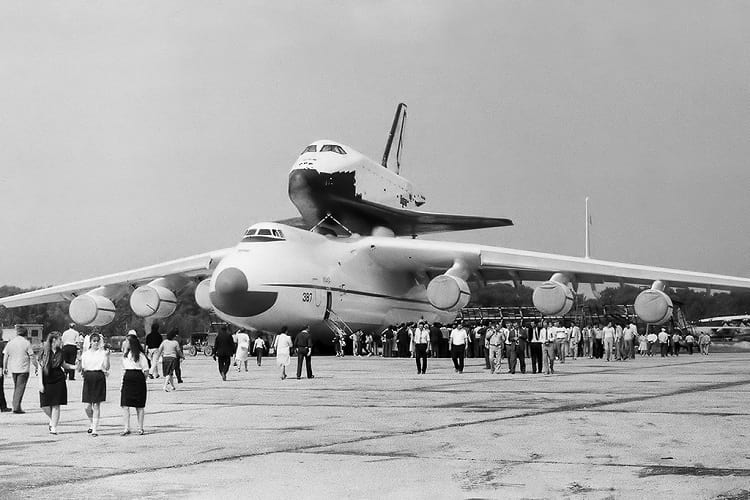
Antonov An-225 Mriya first public appearance at Gostomel Airport, Ukraine. (Oleg V. Belyakov / AirTeamImages)
The Soviet Union was known for its opulent grandeur, none more so than in the field of engineering. Antonov is the name of an aeronautical organization located in Gostomel Airport, Ukraine, famous for building behemoth vehicles. Between the years of 1984-88, they created an aeroplane which still remains as the biggest to ever be manufactured. It is called the Antonov An-225 or Mriya which means dream in Ukrainian. It has of course been heavily upgraded since those years when it was built to carry space shuttles and equipment from Moscow to Kazakhstan – where the Baikonur Cosmodrome lies. That was, unbelievably, the cheapest way of doing so.
Mriya is 84m long (almost as long as a professional football pitch) which is longer than the distance the Wright Brothers reached when they flew for the first time in 1903. It has a maximum speed of 528 MPH and a take-off weight of 640 tons meaning it is twice as heavy as the statue of liberty. The fact that constructs as heavy as Mriya can fly is truly phenomenal.

Antonov An-225 is equipped with three powerful D-18T engines on either side. (Dmitry A. Mottl / Wikimedia Commons)
When Mriya is expected thousands of people come to watch her land or take-off. Other features which impress aviation enthusiasts is the nose of the plane which can detach to allow cargo to be loaded and save weight. It also has a design called a twin tail for extra stability.
If you want to rent the Mriya, it is not cheap at $30,000 an hour. For this reason, it has not been used extensively only around once or twice a year but here are a few examples of its missions. In many of these, it has broken world records for its unique cargo hold capabilities. It was contracted to deliver 216,000 meals to the US military from Stuttgart, Germany to Oman.
In 2009, the heaviest ever single item was delivered to Armenia – a gas generator at an astonishing 189 tons. While the heaviest multiple cargoes was a series of pipelines weighing 253 tons. The longest cargo came one year later with two 42.1m wind turbine blades which came from China to Denmark. Then in 2016, the plane flexed its muscles even more by transporting a 130-ton cargo – another generator – from the Czech Republic (AKA Czechia), all the way to Perth, Australia.

Cargo being loaded in Antonov An-225 Mriya. (Robert Sullivan / Flickr)
Service during catastrophe
Projects like this can be criticized by many. People would ask where the humanity is and the reason for spending this amount of money but the fact is that Mriya can help people too. Humanitarian missions have included delivering generators to Samoa in order to fix electric stations damaged by the 2009 tsunami. The Japanese government also sent machinery to the island of Haiti by means of aid after the 2010 earthquake. Later the French government assisted the Japanese people during a similar catastrophe.
Mriya has recently caught the attention of a new buyer – AIC – the Airspace Industry of China. A private aerospace and defence company they have agreed to buy the An-255 program and within the next ten years, they hope to fill the sky with 1,000 planes. AIC is more interested in the newer version of the Mriya however. In terms of heavy lift – its transportation capacity is unmatched, even able to launch satellites into space at high enough altitudes.
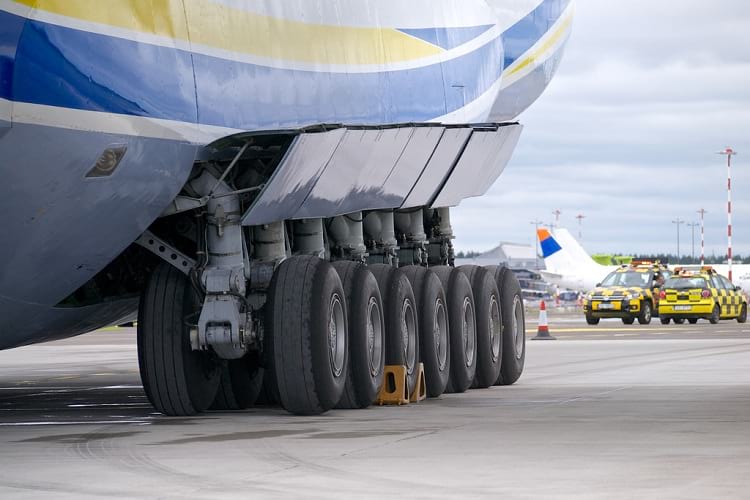
The main landing gear of Antonov An-225. (Kārlis Dambrāns / Flickr)
The CEO of Antonov Airlines, Mikhail Karchenko is disappointed about losing the fleet but knows it is a necessary sacrifice. He stated:
“The Chinese want to buy from us this plane and there’s no harm in it, but of course no one wants to sell the aircraft. The Mriya is not separable from Ukraine, it’s like our child, and it’s something our children, and our grandchildren can always be proud of.”

Antonov An-225 in Sweden, 2012. (Larska / Wikimedia Commons)
Enjoyed this article? Also, check out “Why NASA Loves the Super Guppy Aircraft“.
Fact Analysis:
STSTW Media strives to deliver accurate information through careful research. However, things can go wrong. If you find the above article inaccurate or biased, please let us know at [email protected].
RELATED
The post The Antonov An-225: The Longest and the Heaviest Aircraft Ever Built appeared first on .
]]>